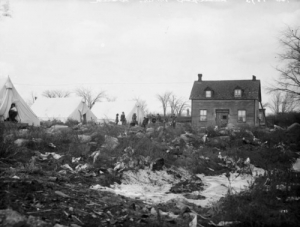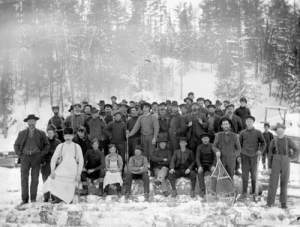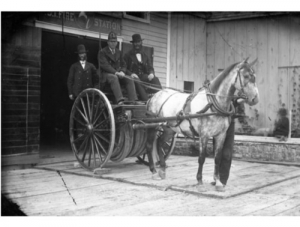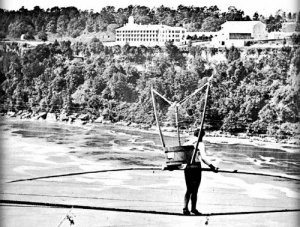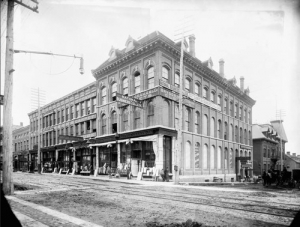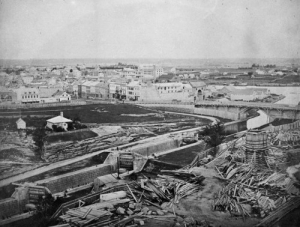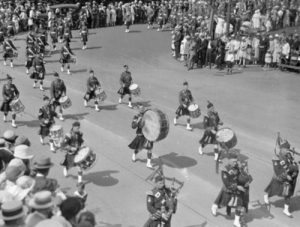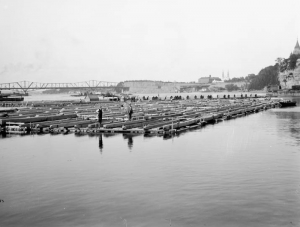James Powell
Smallpox and the Porter Island Isolation Hospital
2 November 1893
Be thankful that you live today and not a hundred years ago. Then, communicable diseases were rampant. Diphtheria, measles, whooping cough, and scarlet fever routinely killed babies and infants. In 1909, the infant death rate in Ottawa was a horrific 283 out of 1,000 live births. (In 2017, the rate of infant mortality in Canada was 4.5 out of 1,000.) Even if you managed to survive the so-called “childhood diseases”, you ran the gauntlet of contracting other lethal illnesses such as cholera, tuberculosis, and typhoid. Epidemics periodically swept through the fetid cities of North America killing thousands. But of all the diseases, the one that people feared the most was smallpox.
 Smallpox sufferer, 1886, Fox, George Henry, Photographic Illustrations of Skin Diseases (2nd Edition), Wikipedia.Smallpox has a long history. There is some evidence that the disease was present in ancient Egypt more than three thousand years ago. More reliably, descriptions of the disease can be found in Chinese medical texts of the 4th century AD. It was prevalent in south-west Asia by the 10th century. By the thirteenth century, people in the Middle East were practising variolation to ward off the disease by inoculating people with the live virus—liquid from a smallpox pustule was rubbed into a scratch in the skin. This was a dangerous procedure, but it conferred life-long immunity.
Smallpox sufferer, 1886, Fox, George Henry, Photographic Illustrations of Skin Diseases (2nd Edition), Wikipedia.Smallpox has a long history. There is some evidence that the disease was present in ancient Egypt more than three thousand years ago. More reliably, descriptions of the disease can be found in Chinese medical texts of the 4th century AD. It was prevalent in south-west Asia by the 10th century. By the thirteenth century, people in the Middle East were practising variolation to ward off the disease by inoculating people with the live virus—liquid from a smallpox pustule was rubbed into a scratch in the skin. This was a dangerous procedure, but it conferred life-long immunity.
Smallpox is caused by the variola virus, and came in two forms: the virulent variola major strain, which had a death rate of about 30 percent, and the less severe but less common variola minor type that had a death rate of about 1 percent. The characteristic symptom of the disease was raised pustules that spread across the body, especially the extremities. Survivors of smallpox often experienced terrible disfigurement and blindness.
By the 15th century, the disease was well-established in Europe. Subsequently, European explorers and traders introduced smallpox to the Americas. Lacking resistance to the disease, Indigenous populations were virtually wiped out. The fall of the Aztec and Inca civilizations in South and Central America was due far more to smallpox than the weaponry of the Spanish conquistadors. In what was to become Canada, European settlers brought the disease to eastern First Nations. Later, the Plains tribes were infected through their interaction with voyageurs and traders. The result was calamitous. Whole communities died. In just one epidemic on the Prairies in the 1830s, two-thirds of the Blackfoot First Nation perished.
A major step towards conquering the disease occurred in 1796. Noticing that dairymaids who had contracted cowpox, a mild disease, appeared to be immune from smallpox, the British scientist Edward Jenner undertook an ethically-challenged experiment. First, he inoculated a young boy with cowpox serum. As expected, the child only experienced a slight fever, a few aches, and a temporary loss of appetite. Two months later, Jennings infected him with smallpox. Fortunately, the boy had no reaction; he was immune as Jennings had hypothesised.
Although several countries enthusiastically embraced vaccination (from the Latin word vacca meaning cow)—Bavaria reportedly introduced mandatory vaccination as early as 1807—it was a hard sell elsewhere. Like today, anti-vaxxers peddled “alternative facts” and received wide press coverage. To give the anti-vaxxers their due, unclean vaccination equipment and unsanitary conditions could cause serious infection in an era long before antibiotics. Vaccinations also didn’t confer lifelong immunity and had to be repeated. However, the risks of contracting smallpox far outweighed the possible side effects of vaccination. But out of ignorance and fear, people still hesitated to get vaccinated, and epidemics continued to claim thousands of lives and maim many more.
Smallpox arrived in Ottawa as early as 1828 with the Rideau Canal workmen. Colonel By apparently averted an epidemic by organizing a speedy vaccination campaign. Fortunately, the disease did not appear to be a major health risk until later in the century. In 1860, the Ottawa Daily Citizen reported that “smallpox and throat disorders [most likely diphtheria] were very general.” Fortunately, fatalities were comparatively rare. In 1871, an outbreak of smallpox was reported in Sandy Hill in the Stewart Street area. In a letter to the editor, “Pro Bono Publico” complained that “cow yards, hog pens, and dirty yards in such abundance as to originate, let alone the nurturing of, disease and pestilence.” Another article reported the unwillingness of civil service men to reclaim their laundry when their washerwoman came down with smallpox, necessitating them to buy new clothes.
Initially, smallpox victims were treated in isolation wards in the Protestant General Hospital located on Rideau Street. Later, such patients were segregated in an annex. In the mid-1870s, despite considerable neighbourhood opposition, the Sisters of Charity opened a second, Catholic, smallpox hospital at the rear of the Catholic cemetery in Sandy Hill. Both hospitals were extensively used in a major smallpox outbreak in 1879-1880. Mortuary statistics show that 219 died of smallpox in Ottawa during 1879. A further 97 died before the epidemic ended by the middle of the following year out of 230 additional cases of smallpox—a mortality rate of 42 percent. (Ottawa’s population at the time was only 27,000.)
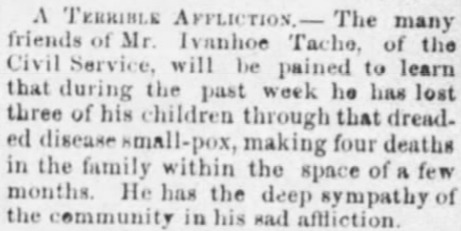 Announcement in the Ottawa Daily Citizen, 9 December 1879. All classes of people of all ages were affected by smallpox. The impact of the disease on families was devastating.When the Protestant Hospital was deemed “dangerous and unsuitable” as an isolation facility, the City began searching for another location for a new smallpox hospital. In 1893, City Council finally chose Porter’s Island, an eight-acre, low-lying property in the Rideau River.
Announcement in the Ottawa Daily Citizen, 9 December 1879. All classes of people of all ages were affected by smallpox. The impact of the disease on families was devastating.When the Protestant Hospital was deemed “dangerous and unsuitable” as an isolation facility, the City began searching for another location for a new smallpox hospital. In 1893, City Council finally chose Porter’s Island, an eight-acre, low-lying property in the Rideau River.
The major factors in favour of Porter’s Island were its relative isolation and price. Under provincial law, a smallpox hospital needed to be at least 450 yards away from inhabited areas. While a number of locations were considered, they were all deemed too expensive or not sufficiently accessible. A committee of city doctors also supported Porter’s Island on the grounds that the flowing water around the island lent itself to cleanliness. Others, however, worried that the damp, low-lying island was unhealthy, and that the island was prone to flooding. The Ottawa Clinical Society noted that there was a highwater mark nine feet above the mid-summer water level, indicating that up to a half of the island could be submerged during the spring freshet.
Despite these misgivings, the City awarded a contract for the construction of a cottage hospital on the island to Mr. John Bruce, the low bidder, for $16,400 on 2 November 1893. Construction commenced as soon as the City formally acquired the land, the price of which was settled through arbitration. (It was set later at $6,713, costs included.) Bruce promised to build three brick hospital buildings, which could accommodate some 100 patients, and a separate administration building. Another contract was awarded to Dominion Bridge Company to construct an iron bridge linking the island to St. Patrick Street for an additional $5,000.
Work on the isolation hospital was suspended three months later after the City had spent $34,000, and with the contractor demanding another $10,000 to complete the job. A local firm of architects, which inspected the site, found shoddy workmanship—the hospital’s foundation was built above the frost line, the brickwork was a third thinner than specified and was already cracking, and the floors were sagging. The next month, with the spring run-off underway, the basement of the administration building flooded just as critics had warned.
Then, the blame game began, with some City alderman saying “I told you so.” Others went into denial. One Island apologist said the situation was “not at all bad” other than a “few blemishes.” In April 1894, an official of the Ontario Board of Health visited Porter’s Island to assess the situation. His report dropped like a bombshell on City Council. He said the island was unfit for a hospital. He recommended against further expenditures on the island for hospital purposes, suggesting instead that the semi-constructed buildings be converted into an incinerator for garbage.
Over the next decade, City Council bickered over what to do with Porter’s Island, how they could re-coup the thousands of dollars spent, and whether the island could ever be used as the location for an isolation hospital. Nothing was resolved. Besides lawsuits, the only action taken was to fire G. F. Stalker, the project’s architect. He died of apoplexy shortly afterwards. Meanwhile, the semi-built hospital deteriorated owing to weather and theft despite the presence of a resident caretaker.
It wasn’t until 1902 that the administration of the Mayor Cook took the bull by the horns and built a new contagious disease hospital located on Regan’s Hill at the old Rifle Range in Sandy Hill (now the location of the Sandringham Apartments). Opening in 1903, the new Strathcona Hospital was designed to treat such diseases as diphtheria and scarlet fever—not smallpox which fortunately was in abeyance. Meanwhile, Porter’s Island was used as a refuse dump. Its derelict hospital buildings were demolished in 1904.
The need for a smallpox hospital returned with a vengeance when a serious smallpox epidemic swept the city in 1910-12. In response, the Ottawa Board of Health converted the caretaker’s frame house on Porter’s Island into a makeshift isolation hospital. When the numbers of smallpox victims rose beyond the capacity of the house, the City erected large tents on the island, notwithstanding it being the middle of an Ottawa winter. The tents were heated using “Quebec heaters” whose warmth extended only a short distance. There was no running water, no modern flush lavatories, and rats abounded, a situation made worse by the continued use of the island as a refuse dump. “Nothing is to be seen apart from the smallpox camp but tin cans, ashes, dead rats, decaying vegetables and fish,” said the Ottawa Evening Journal. Many exposed to smallpox hid in fear of being forced to Porter’s Island. Guards were stationed at the bridge to stop people escaping.
In May 1911, a naval architect and his five children were stricken with smallpox and ordered to Porter’s Island. The architect, an employee of the Public Works Department, reported to the Journal that vermin had eaten through eight military blankets on his bed located in one of the tents, which itself was sited just a few feet from a filthy outhouse. He managed to catch five rats using an improvised trap. Meanwhile his dying eight-year old daughter, who was conveyed to the Island in an ambulance that lacked basic amenities such as sheets and pillows, complained of abuse from one of the nurses. After the story broke, hospital staff said the man had exaggerated, saying he had only caught one rat. As for the charge of abuse, a nurse denied it. However, she admitted to occasionally slapping a child, after all “we had over thirty children at this Island and how could we make them behave and mind them all if we did not do this occasionally.” Remember that these children were in a frightening environment, many of whom were desperately sick, and had been separated from their parents.
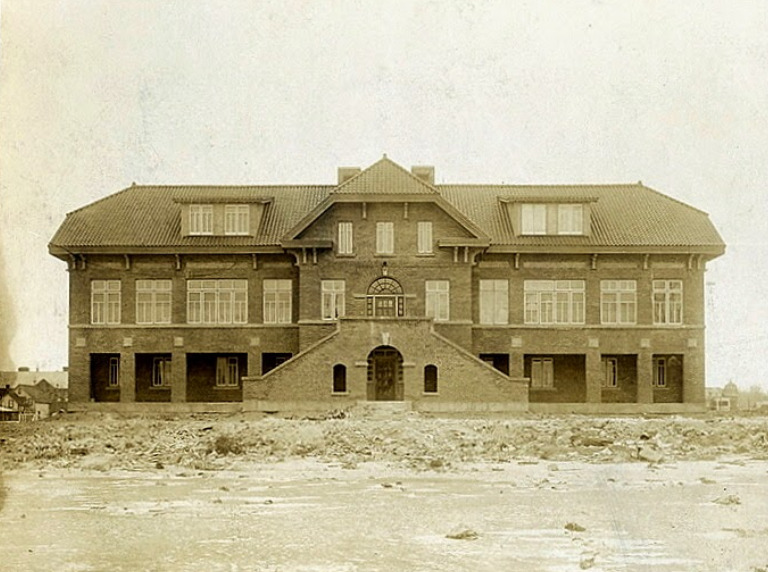 Hopewell Hospital, 1912, Alfred G. Pittaway, Bytown Museum, P893b.In November 1911, on a close 11-10 vote, with Mayor Hopewell casting the deciding ballot, City Council agreed to build a proper smallpox hospital on Porter’s Island. Architect Francis C. Sullivan was commissioned for the job. George A. Crain won the contract to build it at a cost of $30,323 which later rose to more than $45,000. To avoid being flooded in the spring, the 107’ x 37’ brick building was constructed on a raised fill platform. There was no basement. When the new Hopewell Hospital opened in late January 1913, the City burnt the old smallpox shack and tents.
Hopewell Hospital, 1912, Alfred G. Pittaway, Bytown Museum, P893b.In November 1911, on a close 11-10 vote, with Mayor Hopewell casting the deciding ballot, City Council agreed to build a proper smallpox hospital on Porter’s Island. Architect Francis C. Sullivan was commissioned for the job. George A. Crain won the contract to build it at a cost of $30,323 which later rose to more than $45,000. To avoid being flooded in the spring, the 107’ x 37’ brick building was constructed on a raised fill platform. There was no basement. When the new Hopewell Hospital opened in late January 1913, the City burnt the old smallpox shack and tents.
The last big epidemic to hit Ottawa occurred in 1920-1921 with more than 1,000 cases. Fortunately, the infecting strain was relatively mild. There were only two deaths. For a time, the Hopewell Hospital was completely full. At one point during the outbreak, more than eighty houses in Ottawa were also under quarantine. To interdict the disease at the border, the province of Quebec quarantined Ontario. Nobody could enter Quebec, including Quebec residents, from Ontario without an up-to-date smallpox vaccination certificate. Free vaccinations were given in the CPR station in Hull. By mid-year, the epidemic had been halted by a massive vaccination campaign with 40,000 vaccinations given out in Ottawa alone.
By the early 1930s, smallpox had become very rare, and was eradicated in Canada by 1946. With the underused Hopewell Hospital now obsolete, it was converted to apartments in the mid-1940s and demolished in 1967. Its site is currently occupied by the Chartwell Rockcliffe Retirement Residence. The old bridge constructed in 1894 is still standing although it is now closed to the public.
After a concerted global vaccination campaign carried out by the World Health Organization, smallpox was eradicated with the last naturally occurring case recorded in Somalia in 1977. The following year, a medical photographer caught the disease in a laboratory accident in Britain. She died. Currently, the only known smallpox virus stocks are held in the United States and Russia.
Selected Sources:
Fenner, F., Henderson, D. A., Arita, I., Jezek, Z., Ladnyi, I. D., 1988. “Smallpox and Its Eradication,” World Health Organization.
McIntyre John and Houston, C. Stuart, 1999. “Smallpox and its control in Canada,” CMAJ, 14 December.
Ottawa Daily Citizen (The, 1861. “Ottawa in 1860,” 4 January.
——————————-, 1871. “Sanitary Precautions,” 13 May.
——————————-, 1871. “The Effect of Small-Pox on the C.S.” 4 December.
——————————-, 1880. “Mortuary Returns,” 9 January.
——————————-, 1881. “The Health Of The City,” 12 January
——————————-, 1933. “Were Objections When Nuns Put Up Small-pox Hospital,”
Ottawa Evening Journal (The). 1893. “Board of Health Discuss,” 29 August.
————————————. 1893. “And Now For Porter’s Island,” 3 November.
————————————. 1893. “On To Porter’s Island.” 24 November.
————————————. 1893. “The Arbitrators Award,” 29 November.
————————————. 1894. “A Bolt Falls!” 24 Apri.
————————————, 1911. “Rats, Neglect And Filth Features Of A Sojourn On Porter’s Island,” 21 June.
————————————, 1911. “Heated Denials Made By Nurses Upon Island,” 22 June.
————————————, 1913. “Handsome Structure Erected By Famous C. Sullivan, A Young Ottawa Architect,” 8 February.
———————————–, 1920. “Quebec Quarantines Ontario On Account OF Smallpox,” 6 January.
———————————–, 1921. “The Smallpox Risk,” 27 January.
———————————–, 1921. “Smallpox Now Under Control,” 16 February.
Passfield, Robert W. 2013. Military Paternalism, Labour, and the Rideau Canal Project, Bloomington: AuthorHouse.
Riedel, Stefan, 2005. “Edward Jenner and the history of smallpox and vaccination,” Baylor University Medical Center Proceedings, 18 January.
Urbsite, 2014., http://urbsite.blogspot.com/2014/07/the-smallpox-hospital-porters-island.html.
Walker, Kate, 2015. “Medical Ottawa: Ottawa’s Smallpox Outbreak of 1911 And The Origins Of The Hopewell Isolation Hospital,” A Canadian Treasury of Medical History, http://canuckhm.ca/ottawas-smallpox-outbreak-of-1911-the-origins-of-the-hopewell-isolation-hospital/?doing_wp_cron=1552596495.2340080738067626953125.
Story written by James Powell, the author of the blog Today in Ottawa's History.
Retired from the Bank of Canada, James is the author or co-author of three books dealing with some aspect of Canadian history. These comprise: A History of the Canadian Dollar, 2005, Bank of Canada, The Bank of Canada of James Elliott Coyne: Challenges, Confrontation and Change,” 2009, Queen’s University Press, and with Jill Moxley, Faking It! A History of Counterfeiting in Canada, 2013, General Store Publishing House, Renfrew, Ontario. James is a Director of The Historical Society of Ottawa.
The Shiners' War
20 October 1835
Bytown, the future Ottawa, was a rough place to live during the early nineteenth century. The combination of French, Irish, English, and Scottish settlers was a combustible mixture, especially when combined with religious differences, historic grievances, discrimination, a rigid social structure, poverty, and alcohol. Mother Mcguinty’s Tavern, which was located in Corktown amidst the shanties that lined the Rideau Canal, and Firth’s Tavern close to the Chaudière Falls, were notorious watering holes. If those didn’t suit, there were dozens of other legal taverns as well as illegal grog houses to patronize. Drunken fights and brawls were commonplace, especially when the lumbermen and raftsmen, the workers who brought the cut logs downriver, were in town to gather supplies for the lumbering season.
Despite being co-religionists, Irish and French Canadians often duked it out on the streets of Bytown. Folklore has it that Joseph Montferrand, big Joe Mufferaw to English-speakers, fought off as many as 150 Irishmen in 1829 standing in the middle of the Union Bridge that linked Bytown in Upper Canada to Hull in Lower Canada across the Chaudière Falls. The story has it that Montferrand, a muscular lumberman of considerable proportions, dumped each Irishman who challenged him into the Ottawa River. Montferrand came to be seen as a defender of French rights.
Matters only got worse after the Rideau Canal was completed in 1832 and work became scarce. Unemployed Irish canal workers looked for jobs in the lumber industry, a business hitherto dominated by French Canadians. Tempers flared and fists flew. The Irish gained the upper hand against their French Canadian neighbours when they found a champion who organized them. That leader was Peter Aylen. Of Irish extraction, he was born Peter Vallely in Liverpool, England. He came to Canada in 1815, reportedly after jumping ship at Quebec. At some point he changed his name to Aylen. Little is known about his early years in Canada, but by the 1830s he had become prominent in the lumber business in the Ottawa Valley. Aylen hired only Irish workers, a fact that endeared him to the Irish community in Lower Bytown. He was very successful, becoming a member of the “Gatineau Privilege” who obtained a monopoly to cut timber in the Gatineau River area. He also had lumber operations in the watersheds of the Bonnechere and Madawaska Rivers. In the 1830s, Aylen built a substantial stone homestead on Richmond Road which still stands today.
Aylen’s Irish followers were called Shiners. The origins of the term is obscure. One explanation is that it’s a corruption of the French word chêneurs, or fellers of oak. Another has it that they considered themselves to be the shining ones who stood out above all others. Yet other explanations have them named for the shiny tall hats that newcomers wore, or the shiny silver half-crown coins with which they were paid. Regardless, the Shiners were hooligans who terrorized Bytown and the environs for years. Many offences were laid at their doorstep including stripping children naked in the snow, fouling wells, accosting women in the street and shattering windows. On one occasion, it is said that they broke up a funeral cortege and threw the coffin off the hearse into the street.
They were also accused of serious crimes such as assault, arson, rape and murder. On one occasion, the pregnant wife of a farmer called Hobbs, who had somehow crossed the Shiners, was attacked while driving home in a sleigh with other female members of the family. Beaten with sticks, Mrs Hobbs tried to jump to safety. But her clothing caught in the sleigh and she was dragged over the frozen ground before coming free. The Shiners cut her team of horses loose from the sleigh and ran them off. The next day, the horses managed to find their way home. Their ears and tails had been mutilated.
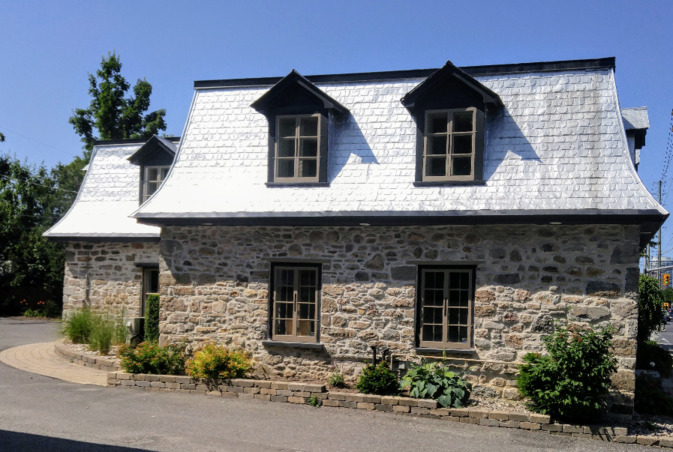 Peter Aylen’s House, built circa. 1830, 150 Richmond Road, Ottawa. In 1914, the home’s substantial out-buildings were destroyed by fire. July 2018, by James Powell.
Peter Aylen’s House, built circa. 1830, 150 Richmond Road, Ottawa. In 1914, the home’s substantial out-buildings were destroyed by fire. July 2018, by James Powell.
According to the Capuchin priest, Father Alexis de Barbezieux, people said “Il n’y a pas de Dieu à Bytown.” (There is no God in Bytown.) Families without news of children who had gone to Bytown to work in the lumber camps feared that they had been killed. Many years later, some believed that in the middle of the night at the Chaudière Bridge (the bridge that replaced the Union Bridge) you could hear the cries of drowned French-Canadian voyageurs and Irish Shiners, the victims of desperate fights who had fallen to their deaths into the rapids below.
In 1835, Peter Aylen stepped up his campaign to control the lumber industry. Shiners began interdicting timber rafts owned by French Canadians going down the Ottawa River to Montreal. Aylen also had bigger ideas—taking over Bytown. Beatings and intimidation increased on the town’s streets. Special constables that were supposed to keep the peace looked the other way, or were in Aylen’s pay. If pursued, hooligans simply crossed the border into Lower Canada and evaded arrest. Even if they were captured, they had to be transported to Perth for trial as there was no jail or courthouse in Bytown. Poorly paid constables were loath to make the perilous fifty-mile journey given the many opportunities for ambush along the way.
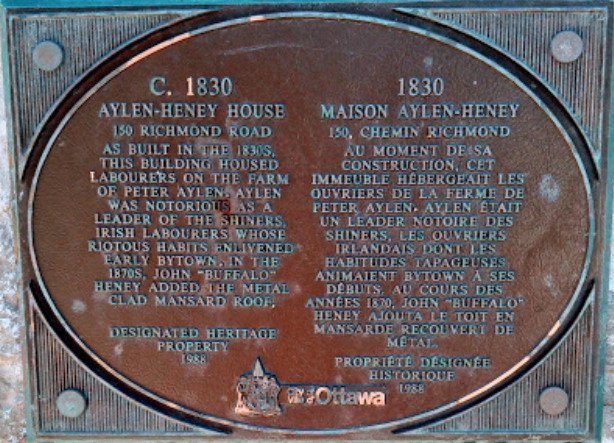 Commemorative Plaque on Peter Aylen’s house, 150 Richmond Road. The home was later owned by the Heney family. July 2018, by James Powell.
Commemorative Plaque on Peter Aylen’s house, 150 Richmond Road. The home was later owned by the Heney family. July 2018, by James Powell.
Despite the anarchy, the community’s wealthy elite in Upper Bytown didn’t take serious action to suppress the Shiners as long as problems were confined to Lower Town. But when the Irish-French feud disrupted the all-important timber trade, and prices rose as farmers became reluctant to bring provisions to lawless Bytown, the town’s merchants woke up to the risks. In August 1835, Peter Aylen challenged the elites politically when he took over the Bathurst District Agricultural Society, the pinnacle of Bytown society life. Drunken Shiners, furnished by Aylen with the necessary one dollar membership fee, overwhelmed authentic members and voted in Aylen and his friends as directors.
With this, Aylen had gone too far. On 20 October 1835, a group of prominent Bytown householders established the Bytown Association for the Preservation of the Peace. They appealed to town magistrates for one hundred guns to arm citizens. Vigilantes made nightly patrols in an attempt to maintain order. As the army based in Barrick Hill was called out only on rare occasions to quell riots, the town formed a volunteer force, the Bytown Rifles, to combat the Shiners. However, the Rifles quickly disintegrated as nobody was willing to serve under its commander, Captain Baker, who was apparently something of a martinet.
Although the vigilantes had some success in keeping the peace, the Shiners continued to terrorize Bytown citizens. In March 1836, the community’s leading lumbermen founded the Ottawa Lumber Association as a further step in suppressing violence in their industry. However, with Aylen as one of its officers, the first act of the new organization was “to improve the movement of timber” on the Madawaska River where Aylen had operations. This likely meant protecting Aylen’s timber interests from angry French Canadians.
In early January 1837, Aylen and his gang disrupted the election of councillors to the Nepean Township Council held in John Stanley’s Tavern in Bytown. While Aylen was elected as one of the three councillors, he demanded that the other two positions be filled with his cronies. A gang of 40-60 of his men, many of whom had arrived at the tavern walking behind a sleigh bearing a portrait of St Patrick, stormed the meeting room, some entering via a broken window. Several of Aylen’s opponents, including James Johnson the founder of The Bytown Independent and Farmer’s Advocate, Bytown’s first newspaper, were violently beaten with sticks and horse whips in the meeting room and in the tavern’s courtyard. Protests that Aylen’s supporters were not Bytown property owners and hence were ineligible to vote went unheeded. The meeting ended in disarray with legitimate attendees fleeing in panic, and the provincial statutes and other important papers destroyed. Order was only restored by intervention of the military.
An official inquiry into the riot was held ten days later by four Bytown magistrates. Most of the dozen or so witnesses who testified blamed Aylen for the affray. Aylen and his cronies did not testify. The magistrates concluded that vigorous measures needed to be adopted to prevent a recurrence of a similar breach of the Peace. They recommended the establishment of a municipal police force and the building of a courthouse and jail in Bytown.
The Bytown Gazette didn’t comment on what it called the “disturbances” until almost eight weeks after the riot at Stanley’s tavern, and only did so with “a good deal of reluctance.” The newspaper cautiously concluded that “our more intelligent readers will doubtless perceive, that a subject of this nature will be viewed in many different lights by different men, that no detail of occurrences with satisfy every one.” It thought there was enough blame to be shared around. “[A]lthough the disturbances have in general been attributed to the Lumbermen, under the cognomen of shiners, there have been instances in which our yeomanry have been the aggressors.” The newspaper also opined that Bytown was being maligned due to the circulation of untrue or exaggerated stories.
Like the magistrates who held the inquiry, the Gazette thought that part of the problem was the lack of a jail. “A wholesome dread of prompt punishment would deter them from committing [crimes].” The newspaper also argued that there were too many unlicensed “Tippling Houses” where men could obtain alcohol. Legal tavern keepers should form an association to stop illegal drinking establishments. This would be an “effectual means of suppressing these hordes of vice from whence so large a portion of these disorders proceed.”
The Gazette stiffened its resolve against the Shiners when in early March 1837 armed men went to the house of James Johnson who had been beaten in the January riot on the pretense of searching for a man. Shots were fired into the upstairs rooms. Fortunately, nobody was hurt. The Gazette fumed that it was “high time measures were adopted to check them.” Poor James Johnson was to suffer yet another attempt on this life a short time later. This time, his three assailants armed with guns and whips nearly succeeded. Ambushed on Sappers’ bridge that linked Upper Town to Lower Town, Johnson had to jump into deep snow to save himself. He was rescued by passersby, but suffered a fractured skull. Fortunately, he recovered.
Unlike in the past when the Shiners could act with impunity, the three men who committed the outrage were captured and taken to Perth to stand trial. Although Aylen broke them out of jail, they were subsequently recaptured in late 1837 and served three years with hard labour in a penitentiary for attempted murder.
By this time, the age of the Shiners was fading. Bytown citizens were themselves becoming better organized and less likely to be cowed. Aylen, who had been charged with a number of offences over the years without any apparent consequence, either sold or rented out his properties on the Upper Canada side of the Ottawa River, and moved to Aylmer on the Lower Canada side. There, he continued in the lumber business. But in Aylmer, he apparently mellowed, becoming a respected member of the community. He even helped to build the area’s first church. He also became a member of the Hull Township Council in 1846, a Justice of the Peace (no joke) in 1848 and the superintendent of roads in the mid-1850s. He died peacefully in 1868.
The Shiners continued to commit acts of violence into the 1840s. But without Peter Aylen at the helm, they faded into history. Ottawa didn’t get a permanent police force until 1863. The Aylen family remained prominent in the Ottawa area. Five generations of Peter Aylen’s descendants have been lawyers, including H. Aldeous Aylen, Peter Aylen’s great grandson, who was appointed to the Supreme Court of Ontario in 1950. In the year 2000, the legal firm of Scott and Aylen, co-founded by the Aylen family almost fifty years earlier, merged with a number of other firms to create Borden Ladner Gervais LLP, now the largest and oldest law firm in Canada with roots going back almost 200 years.
Sources:
Barbezieux, Alexis de, (Father), 1897. Histoire de la Province Ecclesiastique D’Ottawa et la Colonisation dans la Vallée de l’Ottawa, Vol.1, Ottawa : La Cie d’Imprimerie.
Bytown Gazette (The), 1837. “Reported Disturbances in Bytown,” 23 February.
————————–, 1837. “Untitled,” 2 March.
Cross, Michael S, 1973. “The Shiners’ War: Social Violence in the Ottawa Valley in the 1830s,” The Canadian Historical Review, Vol. LIV, No. 1, March, pp. 1-26.
———————, 1976-2018. “Aylen (Vallely), Peter, Dictionary of Canadian Biography,” http://www.biographi.ca/en/bio/aylen_peter_9E.html.
Globe and Mail (The), 2000, “Five law firms wed in cross-country mega-merger, 29 February.
House of Assembly of Upper Canada, 1837. Journal, 1st Session of the 13th Provincial Parliament, Session 1836-37, No. 52 Letter from Magistrates to Mr. Secretary Joseph on the subject of the Bytown Riots, 12 January, W.J. Coates, Printer: Toronto.
———————————————, 1837. “No. 58, Report of the Select Committee on Message of his Excellency the Lieutenant Governor and Documents relative to the Riots at Bytown.” 18 February.
Ottawa Citizen (The), 2014. “John Gordon Aylen, Obituary,” 29 December.
Ottawa Journal (The), 1936. “Christmas In Ottawa One Hundred Years Ago, 19 December.
————————–, 1950. “Name H. Aldous Aylen Supreme Court Justice,” 13 September.
Story written by James Powell, the author of the blog Today in Ottawa's History.
Retired from the Bank of Canada, James is the author or co-author of three books dealing with some aspect of Canadian history. These comprise: A History of the Canadian Dollar, 2005, Bank of Canada, The Bank of Canada of James Elliott Coyne: Challenges, Confrontation and Change,” 2009, Queen’s University Press, and with Jill Moxley, Faking It! A History of Counterfeiting in Canada, 2013, General Store Publishing House, Renfrew, Ontario. James is a Director of The Historical Society of Ottawa.
Ottawa's Champion Hose Reel Team
2 October 1880
The crowds had started to gather at the train station hours ahead of the arrival of the St. Lawrence and Ottawa Railway train from Prescott, anxious to get a glimpse of their “boys.” On board was the Chaudière No. 1 Hose Reel team, the newly crowned “Champions of America” who were returning from an international meet held in the small town of Malone in upstate New York.
Arriving at 6.30 pm, the team was met by an official welcoming committee that included Fire Chief William Young, head of the Ottawa Fire Brigade. At that time, the Brigade consisted of eighteen professional fire fighters located in five stations, each equipped with a two-wheeled hose reels that could be pulled by one horse, or manually if necessary. Also present were Aldermen Lauzon, Coleman and Heney. Outside of the train station, a hook and ladder truck along with No. 1, 2 and 3 hose reels were drawn up in preparation for the parade through the streets of Ottawa. After the customary greetings, a procession formed up, starting with the team’s reel which was decorated with flags and bore a banner strung between two brooms with the word “Champion” written on it. The time being long past sunset, the parade was lit by torches. On their route to the City Hall on Elgin Street, the “boys” were cheered by crowds of Ottawa residents and supporters.
At City Hall, in the absence of the Mayor, Alderman Lauzon welcomed back the champion hose real team of America. He said that after the team’s earlier defeats at Canton and Potsdam, New York, the victory showed what perseverance can accomplish. The victory was being “hailed with pleasure throughout the Dominion.” Alderman Coleman remarked that the win “added another to the long list of trophies won by Ottawa representatives.” Somewhat more tangibly, Alderman Heney promised that as soon as the City was in better financial shape, the fire brigade would get a pay raise.
Hose reel racing was a very popular activity during the late nineteenth century, with competitions organized among fire departments across North America. Agricultural shows often hosted hose reel races, offering significant prize purses to attract the best teams. With serious money to be had, team members were often professionals selected for their speed or brawn to represent a particular fire hall rather than true fire fighters. Betting on these races was fierce.
In a typical hose reel race, a team of up to 18 men competed to draw a 450-pound reel cart carrying 350 feet of hose yards to a fire hydrant. They would then attach and lay 300 feet of hose, break the couplings and screw on a nozzle. Typically, a total of 400 yards would be run from start to finish. The races were timed. A good team could complete the course in a minute or less. Sometimes, two or more teams would race side by side. In early competitions, a team would push the hose reel cart along the track by hand. In later events, the men were tied to the carts, allowing them to put their entire bodies into the push, leaving their arms free. This was a dangerous sport. If a team member couldn’t keep up, he risked falling and being trampled by his team mates or run over by the hose reel cart. Serious injury could result.
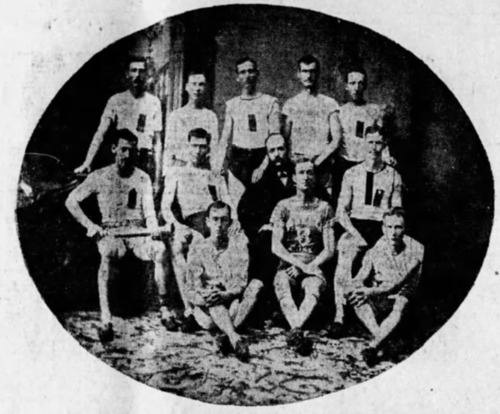 The Chaudière Hose Reel Team, Champions of America, 1880, Topley Studio. Back Row: Cyrille Crappin, W. Cousens, Peter Duffy, “Boston” Ed O’Brien, W. McCullough; Middle Row: Andy Lascelles, Sam Cassidy, Chief William Young, Johnnie Shea; Front Row: J. Newton, Johnnie Raine, and Bob Raine. Missing: W. Grand, B. Leggo, W. Palen, and F. McKnight. Ottawa Citizen, 25 February 1925.
The Chaudière Hose Reel Team, Champions of America, 1880, Topley Studio. Back Row: Cyrille Crappin, W. Cousens, Peter Duffy, “Boston” Ed O’Brien, W. McCullough; Middle Row: Andy Lascelles, Sam Cassidy, Chief William Young, Johnnie Shea; Front Row: J. Newton, Johnnie Raine, and Bob Raine. Missing: W. Grand, B. Leggo, W. Palen, and F. McKnight. Ottawa Citizen, 25 February 1925.
The Chaudière Hose Reel team was formed in LeBreton Flats in 1880. There were in fact at least two hose real teams in Ottawa at this time. At the Fourth Annual Fireman’s Picnic held in early August of that year, the Chaudière Hose Reel team faced the Union Company Hose Real Team which was captained by Cyrille Crappin, a legitimate fire fighter, who belonged to the “Queen Company” stationed at the Nicholas Street Station. At the Fireman’s picnic, organizers had expected that hose real teams from Prescott and Ogdensburg to compete in the same event. But at the last moment, both teams pulled out leaving only the two Ottawa teams in competition. The Chaudière team won the $75 first prize, with the Union team taking home the $30 second prize. Divided among the participants the prizes didn’t amount to much, though it was nice pocket money. This was about to change.
After that early August competition, Crappin joined the Chaudière team. Already a fast team with all its members noted runners—Peter Duffy reportedly ran the 100-yard dash in 9 4/5 seconds—the addition of Crappin took the Chaudières to a new level. He had competed in a number of professional foot races over the previous several years, invariably winning. Most famously, he had defeated a field of a dozen competitors from Montreal, Toronto and the Mohawk First Nation of Caughnawaga in a four-day racing event. Race participants ran continuously for four hours for four consecutive days. Whoever ran the furthest won the competition. The race took place in Powell’s Grove on Bank Street, opposite the Muchmor race track. The hotel located in the Grove sponsored the race. Crappin emerged the victor, having run 119 miles.
With the extra speed and endurance brought by Crappin, the Chaudière Hose Reel team was ready to take on all challengers. Chief Young of the Ottawa Fire Brigade said that he had “from $100 to $1,000 that says that Ottawa can produce a hose reel team…that can beat, and make better time than any hose reel team belonging to any part of the Dominion of Canada.” In September 1880, representatives of the St. Lawrence County Agricultural Society of Canton, New York, who had heard of the Chaudières’ prowess, came to Ottawa to invite the team to compete in Canton’s upcoming hose reel meet. The purse was US$250—a considerable sum of money in those days, equivalent to over US$6,000 today. The Chaudières came in second at the Canton competition behind the Relief Company of Plattsburgh, New York. A few days later, at another meet in Potsdam, New York, the same thing occurred—the Chaudières fell short against the first-place Relief squad. According to hose reel race aficionados, while the team had the necessary speed to win, it lacked an expert coupler. This deficiency was filled by Johnnie Shea who became the new captain of the Chaudière Hose Reel team. Shea hailed from Burlington, Vermont where he had been the coupler for the renowned Barnes Hose Reel team. At Postdam, he asked if he could join the Chaudière team.
After their return to Ottawa with Shea, the Chaudière Hose Reel team practiced on Parliament Hill in front of a large crowd of onlookers and fans to prepare themselves for their next competition to be held in Malone, New York. This time, the purse totalled $450, of which $225 went to the winning team. The Ottawa team arrived two days ahead of the competition which was held on Friday, 1 October on the track of the Franklin County Agricultural Society. They had to borrow all their equipment—the reel from the Blake Hose Company of Swanton, NY, couplings from Chief Engineer Drew of Burlington, Vermont, and the hose from the Blake Hose Company and the Frontier Hose Company of St. Albans, Vermont.
The Ottawa team was met at the Malone train station by the Chief Engineer of the Malone Fire Department and members of the Active Hose Company of Malone. Owing to their late arrival, all the restaurants in the town were closed. Fortunately, the foreman of the Active Hose Company supplied an excellent meal to the hungry Chaudière team who stayed at Hogle House hotel. Owing to rain the next day, the team practiced indoors in a rink. Prior to their arrival, betting had strongly favoured the Relief team. However, once it was known who was on the Chaudière team, the odds shifted heavily in favour of the Ottawa team.
At 10 am Friday morning, six hose reel teams formed up in order of their turn to race—Chaudière Company No.1 of Ottawa, Blake Hose Company of Swanton, NY, the Relief Company No. 2 of Plattsburgh, NY, Washington No. 1 of St. Albans, Vermont, Chamberlin No. 1 of Canton, NY, and the Frontier No.2 of St. Albans, Vermont. The Chaudières and Reliefs came in first tied at 59¼ seconds, necessitating a tie-breaking run. The Ottawa team offered to run the tie-off as a direct race against the Relief squad instead of against the clock. But the Plattsburgh team declined. Betting odds were 2 to 1 on the Ottawa team.
There was considerable excitement among the 8,000 spectators as they waited for the drop of the umpire’s flag. As the Chaudières raced to the finish line, disaster almost happened. A boy who had been running alongside the Ottawa team was apparently pushed “violently” by one of the Relief’s team members into the way of the Ottawa team nearly tripping one of the members. The Ottawa Citizen reported that “fortunately this despicable action did not accomplish what was evidently intended.” Instead, at the finish line, “Shea caught the coupling as it came over the reel…and broke it in a twinkling, with a team member quickly screwing the pipe on “in a masterly and satisfactory manner.” Their time was a phenomenal 58 seconds, easily out classing the Relief Company team who ran next. To great cheers, the Ottawa team drew their reel through the streets of Malone to their hotel. It was reported that the team “carried brooms to show that they had swept the day and also a rake to show the had racked in the cash.”
After their victorious return to Ottawa. Mr. Topley of Topley Studios took the team’s picture in their “full running costume.” Topley had planned to take the picture outside on Parliament Hill, the site of the practice runs. However, inclement weather forced him to take the photograph inside.
The Chaudière Hose Reel team competed the following year in Malone, and won their second American championship, again against the Relief Company of Plattsburgh, NY, taking home the $225 first prize. As a follow-up, the team was slated to race side-by-side with the Wentworth Hose Reel Team of Malone for a $100 prize. Controversially, the Malone team refused to race unless the course was shortened from 400 yards to 300 yards, citing an implicit agreement. The judges ruled against Malone. With the Wentworth Hose Reel team still refusing to run, the $100 was awarded to the Chaudière team. Subsequently, the Franklin Gazette, the Malone newspaper, reported that the Wentworth team was disbanded for their unsporting behaviour.
The success of the Chaudière Hose Reel team may have gone to members’ heads. The Montreal Gazette reported that the team was not willing to compete in any tournament where first prize money was less than $500. By 1882, the Chaudière Hose Reel team appears to have disbanded. In August of that year, Cyrille Crappin, the running star who had helped to bring victory to the Chaudière team in 1880 and 1881, was once again part of the Union Hose Reel Team that was competing in a race for a prize of only $50. There was no mention of the great coupler, Johnnie Shea.
Sources:
Franklin Gazette (Malone), as reprinted in The Ottawa Daily Citizen, 1881. “Hose Reel Racing,” 8 October.
Malone Palladium, as re-printed in The Ottawa Daily Citizen, 1880. “Hose Reel Contests,” 9 October.
Montreal Gazette (The), 1880. “Dominion News, From Ottawa, 3 August.
—————————-, 1880. “Dominion News, From Ottawa,” 24 September.
—————————-, 1880. “Dominion News, From Ottawa,” 28 September.
—————————-, 1881. “Dominion News, From Ottawa,” 16 August.
Ottawa Daily Citizen (The), 1880. “The Firemen’s Picnic,” 6 August.
———————————, 1880. “A Champion Fire Brigade,” 13 August.
———————————, 1880. “The Chaudiere Hose Reel Team,” 28 September.
———————————, 1880. “Return of the Victors,” 4 October.
———————————, 1880. “Photographed,” 5 October.
———————————, 1881. “Hose Reel Competition,” 28 September.
———————————, 1925. “These Were Champions of Champions,” 28 February.
———————————, 1925. “Cyrille Crappin Brought Home The Bacon; Wonderful Distance Runner Of Seventies; Won a Great Victory in Sixteen Hour Race,” 28 February.
———————————, 1925. “Great Pete Duffy In Action,” 25 April.
Story written by James Powell, the author of the blog Today in Ottawa's History.
Retired from the Bank of Canada, James is the author or co-author of three books dealing with some aspect of Canadian history. These comprise: A History of the Canadian Dollar, 2005, Bank of Canada, The Bank of Canada of James Elliott Coyne: Challenges, Confrontation and Change,” 2009, Queen’s University Press, and with Jill Moxley, Faking It! A History of Counterfeiting in Canada, 2013, General Store Publishing House, Renfrew, Ontario. James is a Director of The Historical Society of Ottawa.
The Great Farini Crosses the Chaudière Falls
9 September 1864
Back in the mid-nineteenth century, the world was wowed by Jean François Gravelet, better known as the Great Blondin. In June 1859, in front of a crowd of 25,000 fascinated and horrified onlookers, Blondin crossed the Niagara Gorge from the United States to Canada on a tightrope. On his return trip, he brought a daguerreotype camera with him to take a photo of the spectators.
One of Blondin’s greatest fans was a young man from Port Hope, Ontario named William Leonard Hunt. Hunt was born in June 1838 in Lockport, New York but grew up close to Port Hope where his parents settled after living for a time in the United States. As a child, he was a daredevil and was fascinated with all things related to the circus—much to his parents’ chagrin who view such activities as dishonourable. Hunt gave his first professional performance as a funambulist (tightrope walker) at age twenty-one by crossing the Ganaraska River in Port Hope on a rope stretched eighty feet high between two buildings, just months after Blondin’s conquest of Niagara Falls. Hunt chose the stage name Signor Guillermo (Italian for William) Farini, or the “Great Farini.”
The Great Farini challenged Blondin to a battle of who would be considered the greatest tightrope walker in the world. Signor Farini matched his idol’s feat by crossing the Niagara Gorge in June 1860. He topped off his performance by hanging from the rope mid-river by one hand, then suspending himself by just his feet. On a subsequent trip, after securing his pole, he climbed down a rope to the tourist boat Maid of the Mist circling below in the Niagara River, drank a glass of wine, and then climbed back up to finish his journey across the Gorge.
The rivalry of the two men took off. Blondin walked across the Falls with his feet in bushel baskets, pushed his manager in a wheel barrow, and even cooked omelettes on a portable stove high above the whirlpools, which he lowered to sightseers on the Maid of the Mist below. Farini responded by carrying his much larger manager across the Falls. Mid-river, Farini somehow unloaded his manager onto the rope, crawled on the underside of the rope beneath his friend to emerge on the other side, and then reloaded him onto his back before finishing the crossing. (Where do you find friends like this?!) Subsequently, Farini washed hankies mid-river using an Empire Washing Machine that he had brought with him across the high wire.
Needless to say, Farini was a sensation. It helped that he was darkly handsome, muscular, with brilliant blue eyes and slicked back black hair. He also worn a goatee with a waxed moustache that extended horizontally several inches on either side of his nose in a style popularized by France’s Napoleon III. He was also extremely articulate and spoke several languages.
After a brief stint in the Union Army in the United States during the American Civil War where he rose to the rank of Captain in the Engineers, he returned to the circus. While performing with his first wife, Mary, in a high wire act above the Plaza de Toros in Havana, Cuba in December 1862, tragedy struck. On their fifth crossing with his wife on his back, Mary unexpectedly waved to cheering spectators. Losing her balance, she fell. Somehow, Farini managed to grab her costume as she tumbled past him, but it was not enough. The fabric ripped and she fell sixty feet in front of a horrified crowd of 15,000 people. She died a few days later.
This catastrophe did not stop his high-wire career. In 1864, he came to Ottawa, which was then in the news owing to negotiations underway in Charlottetown, Prince Edward Island among the British colonies in North America on Confederation. If those negotiations were successful, Ottawa would become the capital of a large new nation.
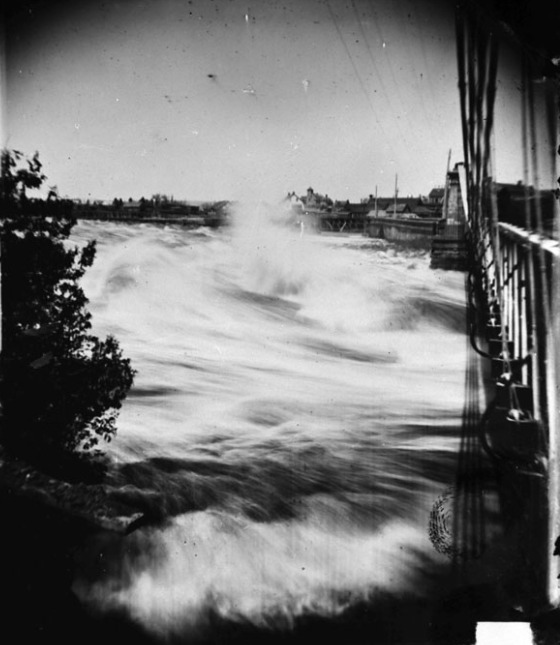 The Chaudière Falls with the Union Suspension Bridge on the right.
The Chaudière Falls with the Union Suspension Bridge on the right.
Circa 1869, Topley Studio, Library and Archives Canada, PA-102695According to Shane Peacock, the author of the definitive biography of the famed tightrope walker, Farini arrived in Ottawa in mid-August, 1864, booking into the Russell House, Ottawa’s premier hotel at the time. His first job was to suss out a likely spot for a high-wire act. He initially thought of crossing the Rideau Canal on a rope strung from Barrick Hill, where the new Parliament buildings were still under construction, to a tower located in what is now Major’s Hill Park. Deciding that such a route was insufficiently death-defying, he chose instead to cross the Ottawa River above the Chaudière Falls. Back in those days, the Chaudière Falls were not the tamed affair they are now but a raging torrent. The Ring Dam that regulates the flow of water over the Falls for the purpose of generating hydro-electricity would not be built for another fifty years. The only way over them at that time, and the only way between Ottawa and Hull, was the Union Suspension Bridge built in 1843. This bridge was later replaced by today’s Chaudière Bridge.
In the days prior to his much advertised crossing, set for Friday, 9 September 1864, work began on suspending a two-inch diameter rope from two heavily-braced wooden towers, one on Table Rock on the Quebec side of the Ottawa River, a short distance upstream from the Union Suspension Bridge, and the other on the Booth lumber mill on Chaudière Island on the Ontario side. The rope was advertised as being 1,000 feet long and 100 feet high. Messrs Perley and Booth along with other mill owners constructed a private viewing stand complete with comfortable seats for the pleasure of Ottawa’s elite. Cost was 25 cents per seat with access to the site provided through the Perley & Company Mill and Brewery or through Mr Booth’s new mill. The general public could watch for free from other vantage points.
The Chaudière Falls stunt wasn’t the only performance planned for Ottawa by the Great Farini. On the Wednesday before his aerial show, Farini gave a charity performance in aid of the new General Hospital, “putting his acrobatic skills at the disposal of the Sisters of Charity.” On the day of his crossing, he also performed at the Theatre Royal where he again demonstrated his gymnastic virtuosity as well as his circus tricks, including the flying trapeze and placing a 400-pound stone on his chest and having somebody smash it with an 18-pound sledge hammer. He also held a man up at arm’s length, a feat that had previously earned him a silver medal from New York gymnasts.
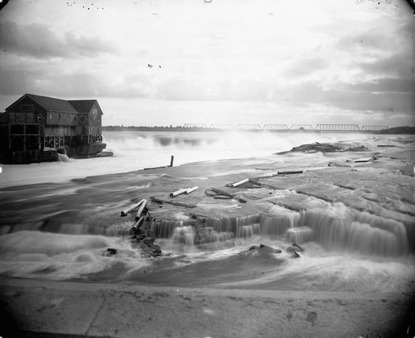 The J.R. Booth Lumber Mill, Chaudière Island, where Farini started his crossing of the Ottawa River. The Prince of Wales Bridge, built in 1880, is in the background.
The J.R. Booth Lumber Mill, Chaudière Island, where Farini started his crossing of the Ottawa River. The Prince of Wales Bridge, built in 1880, is in the background.
Late 19th century, William James Topley, Library and Archives Canada, PA-012377.As you can imagine, there was a lot of press hype for Senior Farini’s death-defying tight rope act across the Ottawa River. Half-price trains and excursion boats ran on the Friday of his performance. A special train brought up U.S. spectators from Ogdensburg, New York with extra ferries laid on to take them across the St Lawrence River to meet a special train leaving Prescott for Ottawa at 8am and to return late that night. The Ogdensburg Advance wrote that Farini was “said to excel the great Blondin, not only in hazardous undertakings, by in ease and grace of their accomplishment.” The newspaper also put a plug in for the Russell Hotel saying that its proprietor, “our friend Gouin,” was “always alive to the comfort and convenience of the public,” and dispensed services that “epicures most delight in.” It added that the Russell House ranked among the finest hotels in Canada, and urged excursionists going to Ottawa to “drop in at the Russell House and ‘smile.’”
Monsieur Gouin, of course, hoped they would do more than smile. He advertised first class rooms at only “$4 US currency per day” for visitors to Ottawa to watch Farini cross the Chaudière Falls. This was a real bargain. With the United States in the midst of its Civil War, US$4 was worth much less in Canadian dollar terms. (In mid-July 1864, the U.S. dollar, which was off the gold standard, touched an all-time low against its Canadian counterpart of US$2.78 to one Canadian dollar.) Of course, visitors could also find the best food and drink at the Russell House.
Friday, 9 September 1864 was a perfect day for Farini’s crossings of the Ottawa River. Two performances were organized, with the first beginning at 3pm and the second at 9 pm after his show at the Theatre Royal. Some 15,000 people turned out to watch. Given that the population of Ottawa was less than 15,000 in the 1861 census this is a remarkable number of people, even allowing for population growth and visitors. One of the best vantage points was on the Union Suspension Bridge. However, fearing an accident given the number of people crowding on to it, the bridge keeper closed the gates leading from the Ottawa side.
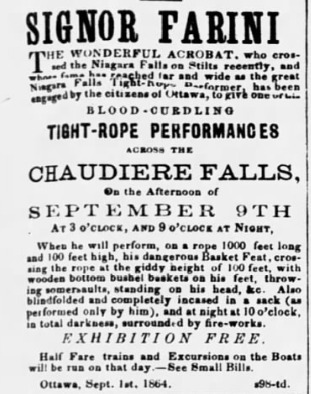 Advertisement for the Great Farini.
Advertisement for the Great Farini.
The Ottawa Citizen, 6 September 1864Spectators were not disappointed. Farini put on a masterful show. Dressed like a circus acrobat, Farini crossed the Chaudière Falls three times during the one hour-long afternoon show. He crossed with and without a pole, did acrobatics, and hanged upside down from his feet over the raging water. On his second trip, he wore wooden bushel baskets typically used for measuring oats on his feet. For a finale, he crossed in a sack.
As Farini was performing, he was almost upstaged by a young boy, no more than eleven years of age, who managed to climb around a fence that jutted out over the fast-flowing river and cordoned off the eastern side of the reserved area at the Perely and Booth mills. When spectators finally saw what the lad was doing, many rushed over to pull him to safety. But before they could do so, he swung himself around the end of the fence, dangling temporarily over the rapids, before pulling himself to safety and disappearing into the milling crowd.
After talking to the press and well-wishers at the Russell Hotel following his afternoon performance, and giving his evening show at the Theatre Royal—tickets were 25 cents each—Farini repeated his Chaudière Falls crossings at 9pm. As it was well past sunset, he performed to the light of fire-works. According to Shane Peacock, he cut short the evening performance at the request of Ottawa authorities who feared an accident owing to the press of the crowds.
Farini left Ottawa shortly afterwards to perform in Montreal; he never returned. By 1866, he had begun regular performances in England with a young boy, Samuel Wasgatt, whom he later adopted. Called El Niño (the child), young Sam and Farini performed as The Flying Farinis. When El Niño got a bit older, he began performing aerial acrobatics as a woman with long blond hair under the stage name “The Beautiful Lulu, the Circassian Catapultist.” He wasn’t “outed” as a man until 1878.
By this time, the elder Farini, had married an English girl, Alice Carpenter, and had retired his leotards in favour of managing celebrity performers and developing new circus tricks, including the first human cannonball act. For a time, he partnered with the famed P.T. Barnum assembling human oddities, included Krao, a hairy Laotian girl who Farini advertised as The Missing Link. He later adopted the girl. During the mid-1880s, the now divorced Hunt, accompanied by his son Sam, the former Lulu, trekked through southern Africa where they claimed to have discovered the Lost Kingdom of the Kalahari. Photographs taken by Sam and a paper written by Farini, which he presented at the Royal Geographic Society in London, caused a sensation…and sparked a decades’ long quest by explorers. Reportedly, some twenty-five expeditions were launched to find the fabled kingdom which stubbornly remained lost.
In 1886, he married his third wife, German-born Anna Mueller. A man of many parts, he took up horticulture, writing books on New Zealand ferns, and begonias. He later began to paint. In the early 1900s, he and his wife moved back to Canada from England. In Toronto, he apparently dabbled in the stock market, and was involved in a gold mining company. He was also an inventor of some renown, including, among other things, folding theatre seats. Moving to Germany in 1909, Farini spent World War I in that country where he wrote a multi-volume account of the war from a German perspective. In 1920, Farini and his wife returned to North America. After moving around a bit, the couple settled down in Farini’s home town of Port Hope, where he died of the flu in 1929 at the ripe old age of 90.
Sources:
Itchy Feet, Itchy Mind, 2014. The Great Farini, Lulu Farini, And The Lost City Of The Kalahari, 2014, https://itchyfeetandmore.com/2014/12/16/the-farinis-and-the-kalahari-lost-city/.
Ottawa Citizen, 1864. “Signor Farini performing at Theatre Royal,” 9 September.
——————, 1864. “Signor Farini,” 6 September.
——————, 1864, “No title,” 7 October.
Ottawa Journal, 1931. “Signor Farini was a Great Rope Man,” 31 October.
——————, 1950. “340 Years of History Flowed by Chaudiere,” 17 June.
Peacock, Shane, 1995. The Great Farini: The Hire-Wire Life OF William Hunt,” Viking: Toronto.
Story written by James Powell, the author of the blog Today in Ottawa's History.
Retired from the Bank of Canada, James is the author or co-author of three books dealing with some aspect of Canadian history. These comprise: A History of the Canadian Dollar, 2005, Bank of Canada, The Bank of Canada of James Elliott Coyne: Challenges, Confrontation and Change,” 2009, Queen’s University Press, and with Jill Moxley, Faking It! A History of Counterfeiting in Canada, 2013, General Store Publishing House, Renfrew, Ontario. James is a Director of The Historical Society of Ottawa.
Ottawa's Greatest Store
6 September 1870
Sparks Street used to be the beating heart of Ottawa commerce, home to several major local department stores that had their roots in the late nineteenth century. These included L. N. Poulin’s Dry Goods store, R.J. Devlin & Company, Murphy-Gamble, and Bryson, Graham Ltd. One by one they disappeared into history. Most were bought out by larger chain stores before they too succumbed as shoppers flocked to exciting new suburban shopping centres with ample parking facilities that were closer to where people lived. But back during the early twentieth century when Sparks Street was at its zenith, the place to shop was Bryson, Graham Ltd, then known as “Ottawa’s Greatest Store.”
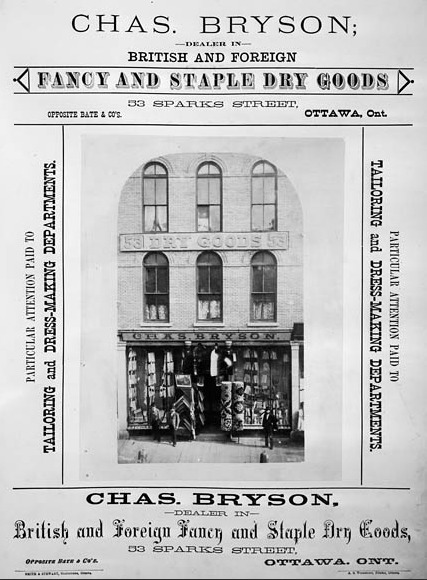 Charles Bryson’s Dry Goods Store, 53 Sparks Street, 1875, William James Topley, Library and Archives Canada, PA-002237.It opened for business on 6 September 1870 as Patterson & Bryson at 53 Sparks Street on the south side of the Street (later renumbered as 110 Sparks Street). The firm was named after its two principals, Joseph H. Patterson and Charles B. Bryson. Initially, there wasn’t much going for the modest dry-goods business. With the main commercial streets in Ottawa at that time being Rideau, Sussex and Wellington, the store had an unpromising location. Business was tough during those early years. Indeed, in 1873, the partnership ended, with Patterson decamping to New York City to establish a dry goods business there. Bryson, a country boy from Richmond who had come to Ottawa in 1864 and learnt the dry-good business working at the firm T. Hunt & Sons, soldiered on alone. The split-up appeared to have been relatively amicable, or at least any hard feelings healed over time. On the firm’s silver anniversary in 1895, Patterson sent Bryson from New York a souvenir of their first day in business. Concealed inside twenty-five nested envelopes was the first 5-cent piece the store took in. On one side was engraved “P & B” with “6th Sept., 1870” inscribed on the other.
Charles Bryson’s Dry Goods Store, 53 Sparks Street, 1875, William James Topley, Library and Archives Canada, PA-002237.It opened for business on 6 September 1870 as Patterson & Bryson at 53 Sparks Street on the south side of the Street (later renumbered as 110 Sparks Street). The firm was named after its two principals, Joseph H. Patterson and Charles B. Bryson. Initially, there wasn’t much going for the modest dry-goods business. With the main commercial streets in Ottawa at that time being Rideau, Sussex and Wellington, the store had an unpromising location. Business was tough during those early years. Indeed, in 1873, the partnership ended, with Patterson decamping to New York City to establish a dry goods business there. Bryson, a country boy from Richmond who had come to Ottawa in 1864 and learnt the dry-good business working at the firm T. Hunt & Sons, soldiered on alone. The split-up appeared to have been relatively amicable, or at least any hard feelings healed over time. On the firm’s silver anniversary in 1895, Patterson sent Bryson from New York a souvenir of their first day in business. Concealed inside twenty-five nested envelopes was the first 5-cent piece the store took in. On one side was engraved “P & B” with “6th Sept., 1870” inscribed on the other.
Things began to pick up in the 1880s after Bryson welcomed Frederick Graham into the business which by this point had moved to 152 Sparks Street. Like his colleague, Graham was a country boy. He had come to Ottawa to sell agricultural equipment for William Arnold on Wellington Street. Dissatisfied with his career choice, he joined Bryson in 1880 and very quickly proved his worth. After only a year, he was offered a piece of the business and became a junior partner. Bryson, Graham & Company was born. It was a partnership that was to last close to fifty years. Bryson took charge of the management of the company while Graham took responsibility for buying. In 1882, Graham became part of the family as well, marrying Miss Margaret Bryson, Charles Bryson’s sister.
During the early 1880s, the duo introduced a radical innovation to Ottawa—“One Price for All.” Hitherto, Ottawa residents haggled with merchants for all their purchases, a process that wasted valuable time and typically left somebody dissatisfied. At the same time, Bryson and Graham advertised “Maximum Value for the Money.” Initially, this novel approach to selling cost the partners business, but the general public quickly caught on.
In one possibly apocryphal story set sometime in the 1880s, ten lumbermen entered Bryson Graham to purchase their gear for the coming logging season. They picked out goods worth $650, a very large sum back in those days. The foreman offered to pay $600. The salesman refused. The foreman then asked if he would throw in a vest for each of the workers. Again, the salesman refused. A pair of braces? Again, the answer was no. The group left the store in a huff, repairing to “The Brunswick” for a drink. They later came back, their leader indicating that they would pay the $650 if the salesman threw in a collar button for each of the men. Again, the salesman refused. When called over, Bryson backed up his salesman and explained the store’s pricing policy to the lumbermen. Giving up and paying the full amount, the foreman admitted that he had bet $10 that he could beat down the store. He added that “it was worth more than $10 to find there is one honest price store in Ottawa.”
The reputation of Bryson and Graham for integrity and straight dealing was the backbone of their company. Over the next fifty years, the company prospered mightily. In 1883, the company expanded eastward, leasing the adjoining store. In 1887, the firm added home furnishings when it acquired the stock and premises of Shouldbred & Company, followed by the acquisition of the stock of dress-goods and silks from Mr John Garland. In 1890, John Bryson, the brother of Charles opened a grocery store in the Bryson-Graham premises. This business was later formally consolidated into the family enterprise. This was a gutsy step. The grocery business in Ottawa had previously been an albatross for other department stores. In 1892, the firm bought the china and crockery business of Mr Sam Ashfield in the neighbouring store. Two years later, the company expanded yet again and acquired the entire block when it took over the corset business of yet another neighbour, Mrs Scott. On their silver anniversary in 1895, the firm built a factory extension to Queen Street.
To mark twenty-five years of progress and expansion, the store’s staff gave Charles Bryson a gold-mounted ebony cane. They also presented a testimonial to their boss reading “…under your control, we are happy to labour, and hope that our constant efforts and devotion to business will meet with your appreciation. With great pleasure do we take this opportunity to congratulate you on your past success, and to say that we are proud to see your business house classed amongst the most important and successful houses of the Dominion.”
Innovations and expansion continued during the store’s second twenty-five years. In 1898, Bryson, Graham & Company was the first in Ottawa to use the “comptometer,” the first successful, key-driven, calculating machine. It was used for adding and calculating work, sales checks, statements and invoicing. In 1909, the partnership was transformed into a limited liability company. Two years later, the company erected a large warehouse on Queen Street to store its extensive inventory.
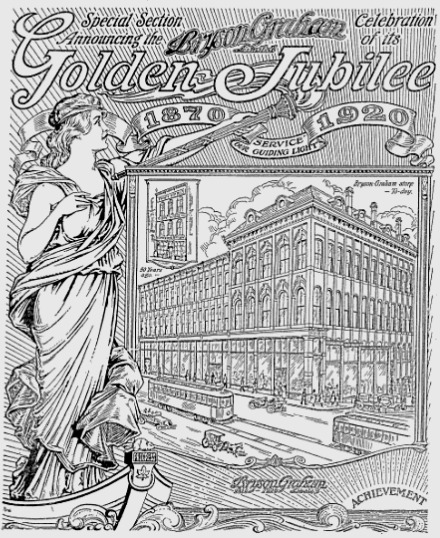 Cover to the Special Supplement in Celebration of Bryson-Graham’s Golden Anniversary, The Ottawa Citizen, 28 February 1920.In 1917, the long and successful partnership of Charles Bryson and Frederick Graham came to an end with the former’s death. Graham became the company’s president, with Mr James B. Bryson, the son of Charles, as vice-president. In 1920, the Ottawa Citizen newspaper celebrated the golden anniversary of the company with a supplement dedicated exclusively to the department store, its history, and its successes. The newspaper opined that the secret of the retailer’s success was the character of Charles Bryson—“his untiring efforts, his forceful personality and his integrity.” The paper also re-published his obituary that stated that Bryson “was a gentleman in business as in his private life; a kind employer, a devoted friend, a real Christian.” The newspaper stated that the many friends of “Ottawa’s Greatest Store” hoped that “the next fifty years will witness an expansion proportionate to that of those gone by.”
Cover to the Special Supplement in Celebration of Bryson-Graham’s Golden Anniversary, The Ottawa Citizen, 28 February 1920.In 1917, the long and successful partnership of Charles Bryson and Frederick Graham came to an end with the former’s death. Graham became the company’s president, with Mr James B. Bryson, the son of Charles, as vice-president. In 1920, the Ottawa Citizen newspaper celebrated the golden anniversary of the company with a supplement dedicated exclusively to the department store, its history, and its successes. The newspaper opined that the secret of the retailer’s success was the character of Charles Bryson—“his untiring efforts, his forceful personality and his integrity.” The paper also re-published his obituary that stated that Bryson “was a gentleman in business as in his private life; a kind employer, a devoted friend, a real Christian.” The newspaper stated that the many friends of “Ottawa’s Greatest Store” hoped that “the next fifty years will witness an expansion proportionate to that of those gone by.”
This wish was not granted. Three years later, in 1923, Frederick Graham died, and the venerable company on Sparks Street passed fully into the hands of the next generation of Brysons and Grahams. James Bryson took over as president and W.M. Graham stepped into the vice-president’s position. For a time, Bryson-Graham continued to do well, but its years of expansion were over. It had apparently transitioned into a comfortable middle age. While it continued to provide a wide range of quality goods to Ottawa customers at reasonable prices, the drive and determination of its founders were gone.
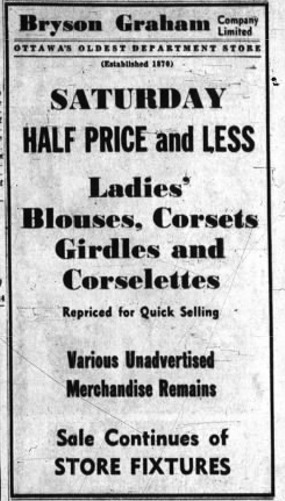 Bryson-Graham’s Last Advertisement, The Ottawa Journal, 17 April 1953Business suffered through the lean years of the Depression and World War II. By the late 1940s, the company was dowdy and old fashioned. In May 1950, Ormie A. Awrey, who had been vice-president and general manager of the firm for the previous eleven years acquired control of the business from the children of the late Charles Bryson and Frederick Graham, buying 85 per cent of the company for $1 million. He later bought the remaining shares. Awrey promised to carry on the traditions of the old firm, but the retailer continued to decline. Parts of the old building were rented out to other retailers, including Bata Shoes, Swears and Wells, and Dolcis. In February 1953, he sold the Bryson-Graham block in February 1953 to J. B. and Archie Dover of Dover’s Ltd for only $310,000. After holding a clearance sale of its stock and fittings, Bryson-Graham, now billed as “Ottawa’s Oldest Department Store,” closed for good on 18 April 1953, ending an 83-year presence on Sparks Street.
Bryson-Graham’s Last Advertisement, The Ottawa Journal, 17 April 1953Business suffered through the lean years of the Depression and World War II. By the late 1940s, the company was dowdy and old fashioned. In May 1950, Ormie A. Awrey, who had been vice-president and general manager of the firm for the previous eleven years acquired control of the business from the children of the late Charles Bryson and Frederick Graham, buying 85 per cent of the company for $1 million. He later bought the remaining shares. Awrey promised to carry on the traditions of the old firm, but the retailer continued to decline. Parts of the old building were rented out to other retailers, including Bata Shoes, Swears and Wells, and Dolcis. In February 1953, he sold the Bryson-Graham block in February 1953 to J. B. and Archie Dover of Dover’s Ltd for only $310,000. After holding a clearance sale of its stock and fittings, Bryson-Graham, now billed as “Ottawa’s Oldest Department Store,” closed for good on 18 April 1953, ending an 83-year presence on Sparks Street.
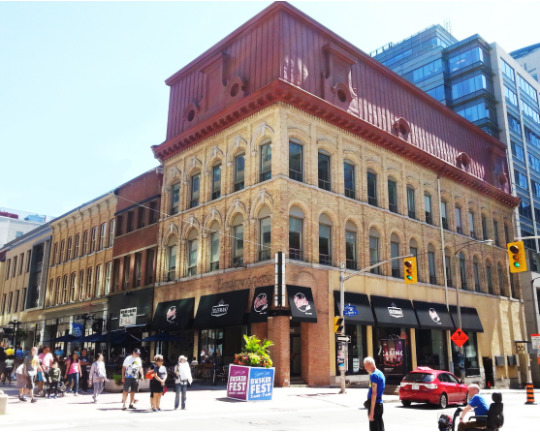 The Bryson-Graham building today, corner of Sparks and O’Connor Streets, July 2017, Nicolle Powell
The Bryson-Graham building today, corner of Sparks and O’Connor Streets, July 2017, Nicolle Powell
Today, the Bryson-Graham building at the corner of Sparks and O’Connor Streets still stands. The ground floor is occupied by Nate’s Delicatessen.
Sources:
Elder, Ken, 2009. Bryson, Graham & Co., Ottawa Canada, http://www.eeldersite.com/Bryson-_Graham_-_Co.pdf.
Ottawa Citizen (The), 1920. “Bryson-Graham Ltd Celebrates Its Golden Jubilee, 28 February.
————————-, 1920. “Silver Anniversary of Store,” 28 February.
————————-, 1920. “Character of Founder Largely Responsible For Store’s Success,” 28 February.
————————-, 1920. “Battery of Comptometers Used in Bryson-Graham’s Stores,” 28 February.
————————-, 1920. “Hard Work One Secret Of The Success Won By Messrs. Bryson-Graham,” 28 February.
————————-, 1920. “One-Price Policy Was Introduced In Ottawa By Bryson-Graham Co.” 28 February.
Ottawa Journal (The), 1895. “A Five Cents With A History,” 10 September.
————————–, 1935. “The Shops of the Capital, What they Were and Are,” 10 December.
————————–, 1950. “O.A. Awrey Acquires Control of Bryson Graham Ltd,” 5 May.
————————–, 1953. “Dovers Buy Bryson Blok,” 12 February.
————————–, 1953. “$10,000, Bryson-Graham Sale Heads May Property Deals,” 4 July.
Urbsite, 2012, Sparks Street Department Stores: Bryson Graham and Company, http://urbsite.blogspot.ca/2012/10/sparks-department-stores-bryson-graham.html.
Story written by James Powell, the author of the blog Today in Ottawa's History.
Retired from the Bank of Canada, James is the author or co-author of three books dealing with some aspect of Canadian history. These comprise: A History of the Canadian Dollar, 2005, Bank of Canada, The Bank of Canada of James Elliott Coyne: Challenges, Confrontation and Change,” 2009, Queen’s University Press, and with Jill Moxley, Faking It! A History of Counterfeiting in Canada, 2013, General Store Publishing House, Renfrew, Ontario. James is a Director of The Historical Society of Ottawa.
The HSO returns–virtually!
Although COVID-19 continues to prevent us from getting together in person, your Society is getting back in action—virtually!
After a successful, virtual, Annual General Meeting held in July, Ben Weiss has organized three fantastic, virtual presentations to kick off our 2020-2021 speakers’ programme. Leading off will be Michael Kent, the curator of the Jacob M. Lowy Collection at Library and Archives Canada. Michael will be speaking to us about Ottawa’s Jewish history on September 16th. Up second on October 14th will be Jo-Anne McCutcheon from the University of Ottawa. Jo-Anne will be examining vintage Ottawa from 1870 to 1920 viewed through today’s digitized lens. Finally, but by no means least, Stephen Jarrett, Project Manager, Archeological Excavation of Parliament Hill 2019, will reveal to us Parliament Hill’s past on November 18th.
The three presentations will be held at 7:00 pm on the dates indicated using the Zoom conferencing system. While we will miss out on the comradery of our in-person get-togethers, one benefit from going virtual is that our members and friends from outside of the Ottawa area will be able to enjoy and participate in the meetings. So, come and enjoy insightful, interesting presentations on Ottawa’s rich heritage and history from the comfort and safety of your own living rooms! All are welcome.
For more details on how to register and watch the presentations, please consult “Upcoming Events.”
Major's Hill: Ottawa's First Park
21 August 1874
One hundred and seventy years ago, Ottawa, was a rude, crude, muddy shanty-town, newly hacked out of the wilderness to be the northern terminus of the Rideau Canal linking Lake Ontario to the Ottawa River. There were few amenities for its roughly ten thousand citizens, many of whom had settled in the area first to build the canal in the late 1820s, and later to exploit the surrounding forests for their valuable lumber for sale to markets in Britain and the United States. But things began to change once Ottawa was selected as the new capital of the Province of Canada in 1857. Lacking the facilities worthy of a capital, work began in 1859 on constructing Canada’s magnificent Gothic-revival parliamentary and governmental buildings on what was then called Barrack Hill, a bluff overlooking the Ottawa River, and is now known as Parliament Hill. Thoughts also turned to beautifying the town, as well as to providing its burgeoning population with satisfactory, outdoor recreational facilities. As early as 1860, a petition was circulated requesting the Provincial Government to convert Major’s Hill, located to the east of Barrack Hill, into a park for Ottawa’s residents. The petition failed. Despite this setback, the hill was unofficially used as a recreational area, hosting weekend concerts by regimental bands. It was also the site for a huge party and bonfire to welcome the birth of the Dominion of Canada on 1 July 1867.
Initially the hill was called Colonel’s Hill, after Col. John By, the supervising engineer responsible for building the Rideau Canal whose residence once stood on the property. (The foundation of the home, which was destroyed by fire in January 1849, is still visible today.) However, after his deputy, Major Daniel Bolton, moved into the home after Col. By was recalled to England in 1832 to answer for cost over-runs in building the canal, the land became known as Major’s Hill. This name stuck. Back in those early years, the hill was thickly forested, and was known for its great flocks of pigeons, most likely the now extinct passenger pigeons. The species migrated in their millions in eastern North America during the nineteenth century, but was sadly exterminated by the early twentieth century through over-hunting and habitat destruction. According to a letter that appeared in the Ottawa Citizen in 1882, sportsmen hunted the pigeons with “every description of flintlock from the Queen Anne to the blunderbuss.”
In 1864, Ottawa’s Mayor Dickenson sounded out the Provincial Government about the city acquiring the land for a public park “for the future Capital of Canada.” (Government—politicians and civil servants alike—was still based in Quebec City awaiting the completion of their new quarters on Parliament Hill.) This petition, like the preceding one, fell on deaf ears. The Provincial Government was not willing to part with Major’s Hill, seeing it as the possible location for the Governor General’s residence. Plans for such a building on that site had been approved in 1859 but ultimately were never used owing to cost over-runs in constructing Canada’s Parliament buildings. Instead, the government chose to rent, and later to buy, Rideau Hall.
In 1873, the Ottawa City Council again approached the now Dominion Government of Prime Minister Alexander Mackenzie about the possibility of acquiring Major’s Hill as the site for a new city hall, or as a public park. The former idea met popular resistance. But this time the idea of a park found traction. On 21 August 1874, the Dominion government accepted a memorial from the City Council under which the city of Ottawa would lease Major’s Hill for the purpose of a public park, agreeing to “protect the trees and shrubberies thereon,” and to “make roads, place seats, plant trees, erect fences” for the duration of the lease. Council also agreed to hire a full-time caretaker for the grounds, and to build and maintain a road, later known as Mackenzie Avenue, between Major’s Hill and the rear line of lots on the western side of Sussex Street (later Drive). The Dominion Government retained its right to tip excavated material from the Parliament grounds into any holes or waste areas on Major’s Hill. As well, the Dominion Government could take back the park at any time should it have need of the land without compensation being paid to the city.
The following year, Ottawa’s City Council set aside $10,000 (a huge sum in those days) for the development of the park under the direction of Robert Surtees, the city engineer, with work beginning in earnest in the summer of 1875 after the city’s plans had received the Dominion Government’s approval. Initial efforts on levelling the Hill actually commenced prior to receiving the official go-ahead. With the economy in recession, City Council authorized Surtees to commence the levelling of Major’s Hill “in order to give employment to our labouring classes, to enable them to prepare for the hard winter, which, to all appearances, is before them.” Subsequently, perimeter fences and gates were erected, and a formal, semi-circular carriage way along with a number of pathways were created inside the park. Low spots were filled in using clay excavated from Parliament Hill, and an artificial pond was created at the northern end of the park. Fountains were installed, and mounted cannon were placed for decoration. On the horticultural side, a variety of trees were planted, including European sycamore, ash, elm, basswood, maple, and tamarack. Flower beds were also laid out.
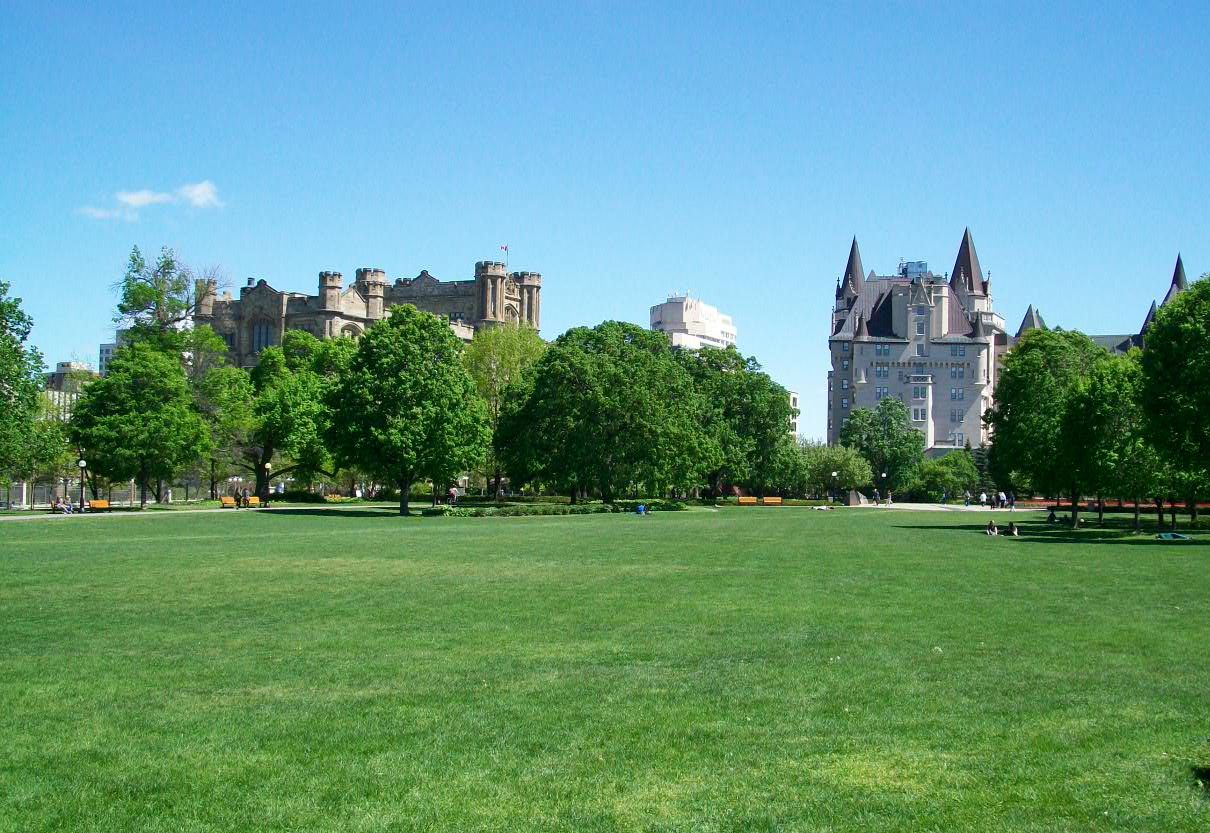 Major’s Hill Park, May 2015, looking south toward the Château Laurier Hotel.
Major’s Hill Park, May 2015, looking south toward the Château Laurier Hotel.
Major’s Hill Park, sometimes referred to as Dominion Park, became a major attraction. However, it seems vagrancy and vandalism were persistent problems. In 1878, City Council passed a by-law excluding from the Park “all drunken or filthy persons, vagrants and notoriously bad characters.” Other rules including a prohibition against driving or riding any horse at an immoderate rate, playing football, throwing stones, or shooting with bow and arrow or firearm. People were also prohibited from letting animals, including horses, cattle, swine, or goats, to run free or feed in the park. There was also an explicit prohibition against “carrying any dead carcase, ordure, filth, dust, stone, or any offensive matter or substance.” On the positive side, the playing of games and the selling of refreshments were permitted with permission, though the regulations stressed that the latter would not be permitted “on the Sabbath Day on any pretense whatsoever.”
After spending some $35,000 over the ten years, the cost of maintaining the park was deemed too large, leading the City to hand back the land to the Dominion Government in 1885. Fortunately, the Dominion Government conserved the Hill as a park. Since then, it has been maintained by various federal departments or Crown agencies, including the Department of Public Works, the Ottawa Improvement Commission, the Federal District Commission and, today, the National Capital Commission.
Being a valuable piece of real estate located in the heart of the city, stretching originally from Rideau Street in the south to Nepean Point in the north, Major’s Hill Park was coveted by many as a desirable building site. After the aborted attempt by the City of Ottawa to construct a new city hall on Major’s Hill during the 1870s, consideration was given in 1901 to building a national museum there in a style that would “harmonize” with the Parliament buildings a short distance away. Fortunately, this idea was not approved. However, a few years later in 1909, the Dominion Government under Sir Wilfrid Laurier controversially sold the southern portion of the park to the Grand Trunk Railway (GTR) for the then huge sum of $1 million to build a magnificent hotel—the Château Laurier. The hotel and Union Station railway terminal also built by the GTR on the opposite side of Rideau Street were key elements in Prime Minister Laurier’s plan to make Ottawa the “Washington of the North.” The proceeds of the land sale went to the Ottawa Improvement Commission to develop Nepean Point.
In 1888, the park received its first statue, that of a uniformed guardsman wearing a bearskin hat with his head bowed in mourning and his rifle reversed. It was erected to commemorate the deaths of Ottawa-born Privates W.B. Osgood and J. Rogers, members of the Sharpshooter’s Company who were killed at the Battle of Cut Knife Hill three years earlier in the Riel Rebellion in western Canada. This memorial, which was unveiled in the presence of Prime Minister Sir John A. Macdonald, his Cabinet, as well as Ottawa’s Mayor and other members of city council, was located close to the southern entrance to the park. When that part of the park was sold to the GTR, the statue was relocated to Elgin Street in front of the old city hall that burnt to the ground in 1931. When the National Arts Centre was constructed on that site in the late 1960s, the statue was moved again, this time to outside the Cartier Street Drill Hall where it stands today.
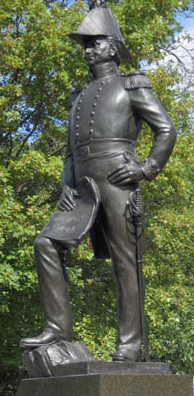 Statue of Colonel By erected in 1971.
Statue of Colonel By erected in 1971.
In 1971, a statue of Colonel By, sponsored by the Historical Society of Ottawa, was erected in the park as a fitting tribute to the man most responsible for the building of the Rideau Canal, and the founding of the city of Ottawa. The statue by the sculptor Joseph-Émile Brunet, which stands on a granite plinth, portrays the man in his Royal Engineer uniform looking over the Rideau Canal towards the Parliament buildings.
Today, Major Hill’s Park remains as integral part of Ottawa life, offering downtown workers and tourists alike a welcome, verdant space in the heart of the city to rest and play. As was the case almost 150 years ago, Major’s Hill continues to be the focus of city events and celebrations, in particular the annual Canada Day festivities.
Sources:
City of Ottawa, 1864. “Council Minutes,” Petition by Mayor M.K. Dickenson address to the Commission of Crown Lands, re: possible acquisition of Major’s Hill for a public park,” 18 June.
——————, 1974. “Memorial presented to His Excellency to take possession of Major’s Hill and covert the Hill into a park for the use of the public,” 21 August.
——————, 1875. “Council Minutes,”16 August.
——————, 1878. “By-Law #439, “To provide for the maintenance and care of Major’s Hill Park,” 8 July. 2015. “Major’s Hill Park,”
National Capital Commission, 2015. “Major’s Hill Park,” ncc-ccn.gc.ca/places/majors-hill-park.
Newton, Michael, 1981. Lower Town Ottawa, Vol. 3, 1854-1900, Manuscript Report #106, Heritage Section, National Capital Commission.
Ryan, Christopher, “Sharpshooters’ Ambulatory Memorial,” The Margins of History, www.historynerd.ca/?p=260.
Sibley, Robert, 2015. “A haunting monument to Col. By,” Ottawa Citizen, www.ottawacitizen.com/pdf/storiesinstone/storiesinstone11.pdf.
The Globe, 1901, “Site For The New Museum? Advantages of Major’s Hill Park,” 26 October.
————-, 1909. “For a Park and Driveway,” 17 June.
The Ottawa Citizen, 1874. “Major’s Hill Park,” 16 February.
Images:
South End of Major’s Hill, circa 1860, looking from the Parliament Hill construction site. Major’s Hill, located, on the far side of the Rideau Canal, has been largely denuded of trees, photo by Samuel McLaughlin, Library and Archives Canada, c-000601.
Major’s Hill Park, May 2015 by Nicolle Powell
Colonel By statue, Historical Society of Ottawa, www.historicalsocietyottawa.ca.
Story written by James Powell, the author of the blog Today in Ottawa's History.
Retired from the Bank of Canada, James is the author or co-author of three books dealing with some aspect of Canadian history. These comprise: A History of the Canadian Dollar, 2005, Bank of Canada, The Bank of Canada of James Elliott Coyne: Challenges, Confrontation and Change,” 2009, Queen’s University Press, and with Jill Moxley, Faking It! A History of Counterfeiting in Canada, 2013, General Store Publishing House, Renfrew, Ontario. James is a Director of The Historical Society of Ottawa.
Ottawa's Centenary
16 August 1926
In 2026, Ottawa will celebrate its bicentenary, marking two hundred years from when General George Ramsey, 9th Earl of Dalhousie and Governor General of British North America, wrote to Lieutenant-Colonel John By advising By of his purchase of land for the Crown that contained the site of the head locks for the proposed Rideau Canal on the Ottawa river, and the suitability of the locality for the establishment of a village or town to house canal workers. Lord Dalhousie asked Colonel By to survey the land, divide it into 2-4 acre lots and rent them to settlers, with preference to be given to half-pay officers and respectable people. The rough-hewn community, which was subsequently hacked out of a hemlock and cedar forest, was quickly dubbed Bytown. Its name was changed to Ottawa in 1855, and two years later the town was selected as the capital of the Province of Canada by Queen Victoria.
To celebrate the centenary of its founding by Col. By, the City of Ottawa had a week-long, blow-out extravaganza in the summer of 1926. Although the official opening of the celebrations was on Monday, 16 August 1926, the fun actually began two days earlier on the Saturday with a range of sporting events wide enough to please the most die-hard sports fanatic. The Capital Swimming Club staged a centennial regatta in the Rideau Canal opposite the Exhibition Grounds—a daring event given the poor quality of Canal water. Swimmers from across Canada participated with five Dominion championships at stake. At Cartier Square on Elgin Street, four soccer teams competed for the McGiverin Cup with the Ottawa Scottish emerging the victor, beating the Sons of England with a 5-2 score in the finals. Also featured that day were track and field events, cycling, golf, baseball, tennis and a cricket match at the Rideau Hall cricket pitch.
The following day, there was a huge Garrison Church parade involving 3,000 soldiers including local regiments as well as the Queen’s Own Rifles from Toronto and the Royal 22nd Regiment from Quebec City who had been quartered in tents on the grounds of the Normal School on Elgin Street (now the Heritage Building of the Ottawa City Hall). The troops marched from downtown to Lansdowne Park where 15,000 people crowded into the stands for divine services. More than 50,000 people watched the soldiers march through the streets of Ottawa. That evening the band of the “Van Doos” gave a concert that was broadcast from the Château Laurier hotel.
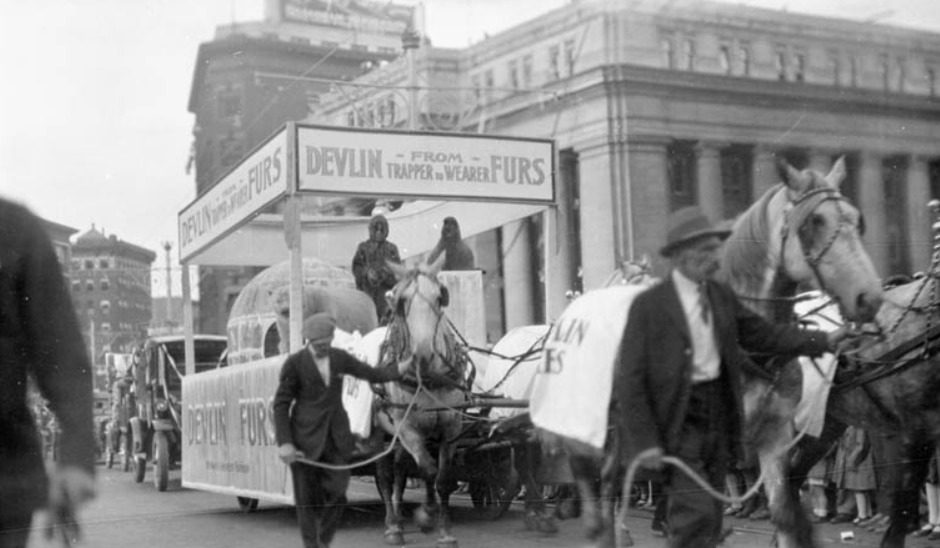 Devlin Furs’ Float, Trades & Industry Pageant, August 1926, Samuel J. Jarvis/Library and Archives Canada, PA-025130.
Devlin Furs’ Float, Trades & Industry Pageant, August 1926, Samuel J. Jarvis/Library and Archives Canada, PA-025130.
The official opening ceremonies took place on the Monday morning on Parliament Hill in front of cheering thousands and “in the shadow of the nearly completed “‘Victory Tower.’” (The name for the Centre Block didn’t officially become the “Peace Tower” until the following year—the 60th anniversary of Confederation.) After much military pomp and pageantry, Sir Henry Drayton, delivered the opening speech in the absence of the Prime Minister, Arthur Meighan. He welcomed visitors to the Capital in the name of the Dominion of Canada. Mayor John Balharrie also greeted visitors and former Ottawa residents who had come home for the celebrations. To symbolized the granting to them of the “freedom” of the city, he released a coloured balloon that carried aloft a four-foot golden key. Messages of congratulations flooded into Ottawa from near and far. Three Governors General—Aberdeen, Connaught and Byng—sent telegrams, as did the Lord Mayor of London, and Jimmy Walker, the controversial and flamboyant Mayor of New York. Civic, provincial and federal politicians from across Canada did likewise.
After the official opening, sporting events occupied the rest of the day. That night, there was a military display and tattoo involving troops from all services in from of 12,000 spectators at Lansdowne Park. The chief feature of the night was the staging of a mock battle scene. As searchlights played over the field, the soldiers re-enacted the crossing of the “Hindenburg” line by Canadian troops in 1918. The mock machine gun action and field bombardment was apparently very realistic. So much so that many veterans experienced flash-backs of their time in the trenches. Also featured that night was a performance of the 1,000 voice Centenary Choir, platoon drills by the Royal 22nd Regiment, and gymnastics displays by cadets.
A highlight of Tuesday, the second day of the Centenary celebrations, was the unveiling of a stone memorial dedicated to Colonel By in a small a park located on the western side of the Rideau Canal just south of Connaught Square opposite Union Station. To the strains of Handel’s Largo, played by the band of the Governor General’s Foot Guard, the memorial, which was covered by a Union Jack, was unveiled at noon. Mayor Balharrie presided. More than 2,000 people witnessed the solemn event. The bronze plaque on the side of the stone, which was intended to be the cornerstone of a much larger memorial, bore the inscription 1826-1926 In Honour of John By, Lieutenant Colonel of the Royal Engineers. In 1826 he founded Bytown, Destined to Become the City of Ottawa, Capital of the Dominion of Canada. This memorial was unveiled in Centenary Year. (A larger memorial was never built. A statue of Colonel By sculpted by Joseph-Émile Brunet was eventually commissioned by the Historical Society of Ottawa and was erected in Major’s Hill Park in 1971.)
At Lansdowne Park, a multi-day western rodeo and stampede commenced with over 200 horses, 100 cattle, and dozens of cowboys from western Canada and the United States. Log rolling competitions took place on the Canal. That evening, an historical pageant was held involving 2,000 actors from service groups, theatre groups, and drama schools. The pageant began with a prologue depicting Confederation with Miss Canada seated on a throne exchanging greetings with Misses Provinces. After pledges of mutual support and loyalty, the provinces curtsied to Canada. This was followed by tableaux representing scenes from Ottawa’s history, including “The Spirit of the Chaudière,” depicting the region before the arrival of Europeans, “The Coming of the White Man,” “Pioneer Settlers,” “The Lumber Industry,” “Bytown and its Early Inhabitants,” “The First Election,” “Naming of the Capital,” “The Fathers of Confederation,” and, a finale where all joined together with the Centenary Choir to sing a closing anthem. The massed 1,000-member Choir accompanied by the G.G.F.G. band also performed a number of popular songs including, O Canada, Land of Hope and Glory, Alouette, Indian Love Song, and, of course, God Save the King.
The pageant got a mixed review. The Ottawa Citizen opined that it provided a “felicitous treatment of the historical episodes chosen for presentation,” but there was “room for improvement.” However, on balance, the pageant was “stimulating and educative.” The dancing was described as “effective.”
After the performance, street dancing was held from 11pm to 2am on O’Connor Street between Albert Street and Laurier to the tunes of two jazz orchestras. With the crush of people, there was little actual dancing though things got a bit better on subsequent nights. With massive crowds downtown, there was some minor trouble. The police arrested a number of young men for setting off firecrackers in the streets. Some had placed “torpedoes” on the street-car tracks that caused “terrific successive explosions” as the trams went over them. Police also acted to curb dangerous driving on the crowded city thoroughfares. Reportedly, louts also molested young women. Generally speaking, however, the street partying was carried out in good humour. A dozen youths organized an impromptu game of leap frog on Sparks Street between Bank and Elgin Streets.
Wednesday, 18 August, was declared a civic holiday by Mayor Balharrie, and more commemorative plaques were unveiled. In addition to non-stop sporting events, rodeo competitions and other fun activities at the Exhibition Grounds, one thousand guests attended a garden party at Rideau Hall. Although Lord Byng had left Ottawa to return to Britain, his term of office as governor general having just ended, he had given permission for the residence to be used as the venue for the civic birthday party celebration. Mayor Balharrie provided a massive four-tier cake decorated with silver foliage and tiny silver cupids. Guests received little boxes of cake bearing the inscription “A souvenir of Ottawa’s Centenary with the compliments of Mayor J. P. Balharrie.”
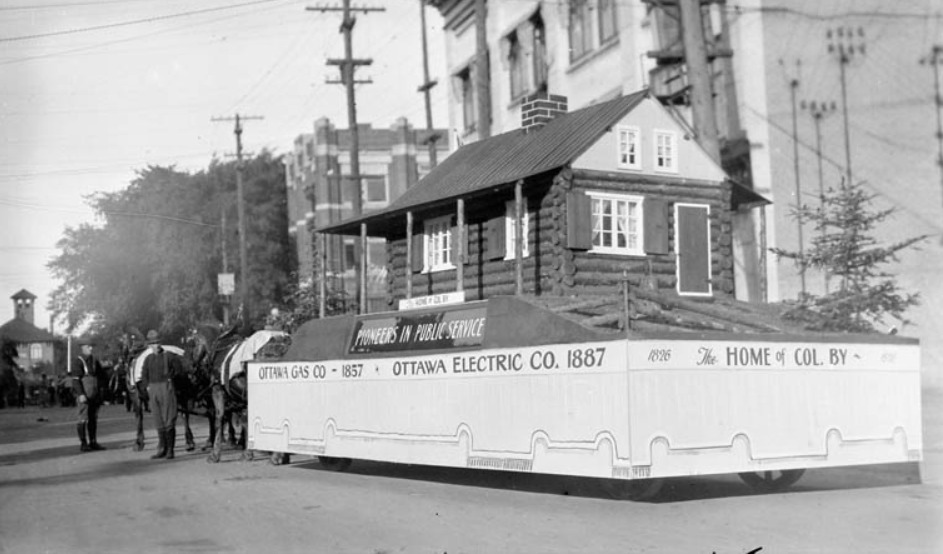 Float of the Ottawa Electric Company, Col. By’s Home, Trades & Industry Pageant, August 1926, Samuel J. Jarvis/Library and Archives Canada, PA-025127.
Float of the Ottawa Electric Company, Col. By’s Home, Trades & Industry Pageant, August 1926, Samuel J. Jarvis/Library and Archives Canada, PA-025127.
That evening, Ottawa’s merchants and businesses held the second of the week’s three parades. Starting in the Byward Market and ending at Lansdowne Park, the parade highlighted milestones of Ottawa’s commercial progress over the previous one hundred years. Among the many entries, the Producers’ Dairy’s float featured a huge milk bottle and milk maids. Camping equipment in 1826 and 1926 was the theme of the Grant Holden and Graham entry. Also in the parade was the largest shoe ever manufactured in Canada with six little girls seated inside it, courtesy of Ottawa’s boot and shoe stores. Representing the Ottawa Department Stores Association, four white horses with attendants dressed in white and yellow uniforms pulled a float bearing eight young women in long gowns. Not to be outdone, the A. J. Freiman entry, which was decorated in silver and flowers, was drawn by six white horses with six attendants dressed in white and blue livery. On board were five young ladies wearing period costumes. The Ottawa Electric Company float consisted of an (inaccurate) replica of Colonel By’s house. Instead of a pioneer’s log home as depicted, the Colonel’s actual home was made of stone.
With amusements and events continuing at the Exhibition Grounds, Thursday’s highlight was an “old timers’ parade. In front of immense crowds, historical floats, three bugle bands, three brass bands and one band of bagpipers wended their way slowly from the Byward Market, along Rideau and Sparks Streets before heading down Bank Street to Lansdowne Park. Old-time vehicles on display included an 1897 Oldsmobile and penny-farthing bicycles. Firefighters dressed in the red outfits of yore pulled hand reels or drove antique horse-pulled engines including the “Conqueror,” Ottawa first fire engine. There were also historical tableaux depicting the early days of the Ottawa Valley and Bytown, including Champlain and his men, the arrival of the Jesuits, the establishment of the first white settlement in the region by Philemon Wright, and the beginning of the lumber industry. Guests of honour in the parade included veterans from the Fenian Raids, the South African War and the Great War.
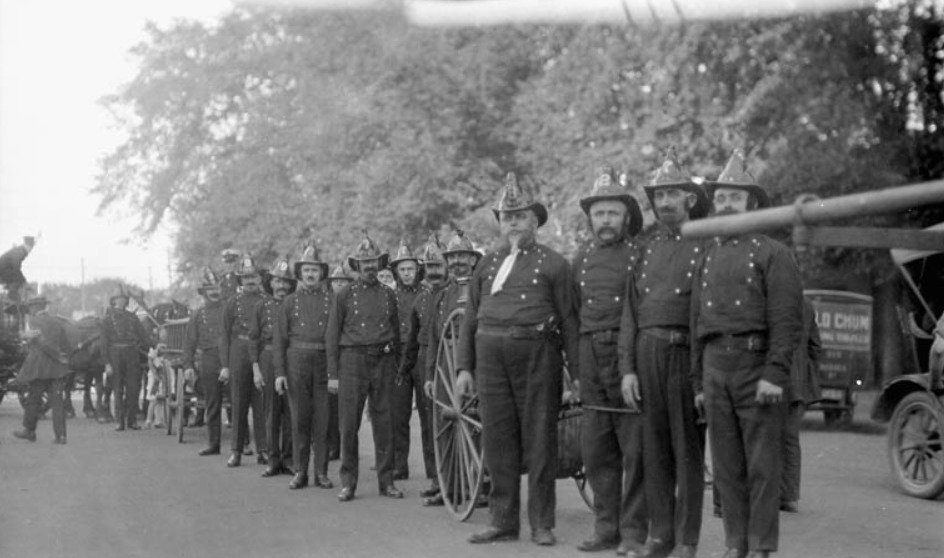 Ottawa Firefighters with hand reels, “Old-Time Pageant,” Ottawa Centenary, August 1926, Trades & Industry Pageant, August 1926, Samuel J. Jarvis/Library and Archives Canada, PA-025131.
Ottawa Firefighters with hand reels, “Old-Time Pageant,” Ottawa Centenary, August 1926, Trades & Industry Pageant, August 1926, Samuel J. Jarvis/Library and Archives Canada, PA-025131.
Centenary celebration wound down on the weekend but not before the finals of the stampede, more street dancing, this time in Hintonburg, more sporting activities, and a “Venetian Nights” boating event held on the Rideau Canal.
For those who hadn’t had their fill of fun and games, the Central Canada Exhibition opened immediately after the official ending of the centenary fun, prolonging the excitement for another week.
Both of Ottawa’s major newspapers covered in detail highlights of Ottawa’s first hundred years and centenary events, with each publishing extended supplements. The Evening Citizen boasted that its edition of 16 August weighed in at more than two pounds. It’s rival, The Ottawa Evening Journal, ran a close second. In one regard, however, the Journal went one step further by publishing a fascinating prospective view of what Ottawa might look like on its bicentenary in 2026. Some of its guesses look pretty accurate. It predicted that Ottawa would have a population of 975,000 (actual number 934,240 in 2016) and that it would annex neighbouring communities. It also correctly forecast the elimination of the above-ground, cross-city train tracks and the replacement of the tram lines with buses. It even predicted a tunnel between LeBreton Flats and downtown used by electric trains!
Not surprisingly, however, the crystal-ball gazers got a lot of things wrong. The newspaper predicted that Canada would have a population of 100 million by 2026, and that the airplane would effectively eliminate the automobile as a mode of transportation. The paper also postulated that after decades of delay the great Georgian Bay Ship Canal would finally be completed in 1982, almost eighty years after the idea was first proposed, thereby making Ottawa a deep-water port with direct access to the Atlantic Ocean. As well, given the region’s cheap hydro-electric power, the Journal envisaged a massive expansion of manufacturing in the Ottawa area, forecasting that the Capital would become the home of the largest Canadian plant for the manufacture of pleasure, commercial and air taxicabs. It also predicted the emergence of a large furniture manufacturing industry in Chelsea in West Quebec, and the construction of immense iron ore smelters in Ironside, just north of the old city of Hull, to process iron ore mined in the Laurentians.
For the Journal, the demise of manufacturing and the conversion of Ottawa into the primarily white-collar city that it is today were unimaginable.
Sources:
The Ottawa Evening Citizen, 1926. Various issues, 14-24 August.
The Ottawa Evening Journal, 1926. Various issues, 14-24 August.
Story written by James Powell, the author of the blog Today in Ottawa's History.
Retired from the Bank of Canada, James is the author or co-author of three books dealing with some aspect of Canadian history. These comprise: A History of the Canadian Dollar, 2005, Bank of Canada, The Bank of Canada of James Elliott Coyne: Challenges, Confrontation and Change,” 2009, Queen’s University Press, and with Jill Moxley, Faking It! A History of Counterfeiting in Canada, 2013, General Store Publishing House, Renfrew, Ontario. James is a Director of The Historical Society of Ottawa.
The Last Timber Raft
8 July 1908
These days, Ottawa has become a synonym for “the government” much to the chagrin of the city’s residents. Newspapers constantly complain about things that “Ottawa” has done. This is understandable since government is the principal industry of the city. One in five jobs in the Ottawa-Gatineau area is with the federal government, a fraction that rises to one in four if you include other levels of administration. This wasn’t always the case. At the beginning of the twentieth century, trees, not politics, were central to the economic prosperity of Ottawa, and of Hull, its sister community on the other side of the Ottawa River. Saw mills and pulp and paper factories which crowded the shores of the Ottawa River, especially in the Chaudière district, employed thousands. Communities the length of the Ottawa Valley also depended on the forestry business, felling and shipping logs to Ottawa and Hull for processing.
The lumber business in the Ottawa Valley began with Philemon Wright, the man from Woburn, Massachusetts who led the first Europeans to the region, settling on the north shore of the Ottawa River in 1800 in what would later be called Hull, Quebec. The settlers, initially intent on farming, discovered a pristine forest that stretched for as far as the eye could see. By one estimate, the untouched Ottawa Valley, in which the land’s Indigenous people had liven for countless generations, comprised 28 million acres of dense woodland. The settlers quickly turned to exploiting this vast and seemingly inexhaustible resource, containing more than 500 billion board feet of valuable timber (A board foot is a measure of lumber volume, being one foot by one foot by one inch.)
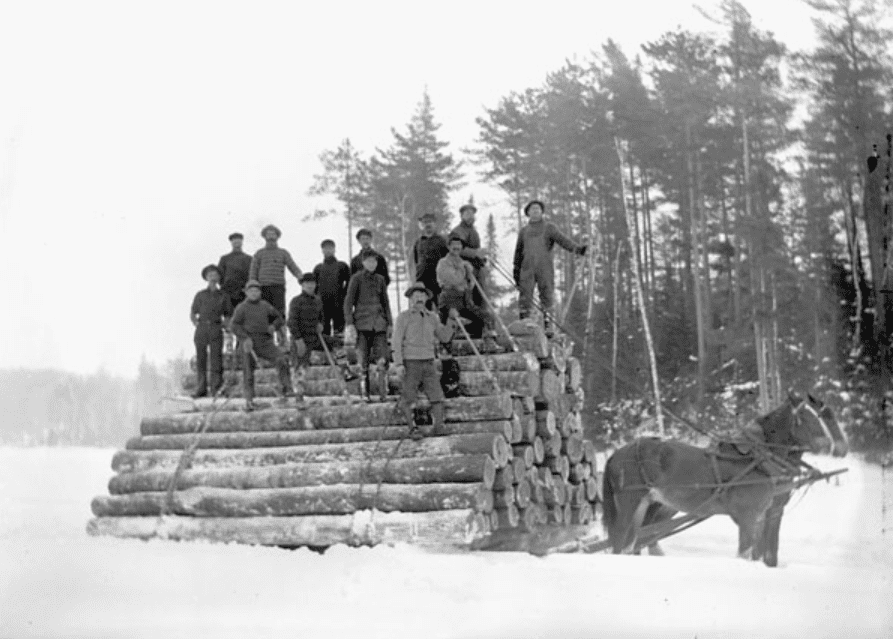 Hauling Logs in the Ottawa Valley, Topley Studio, Library and Archives Canada
Hauling Logs in the Ottawa Valley, Topley Studio, Library and Archives Canada
This ancient woodland was very different from what little remains of the Valley’s forest today. It was estimated that roughly one half of the original forest was made up of white and red pine. A further 45 per cent consisted of other soft woods, such as spruce, balsam and hemlock. The remaining 5 per cent of the woodland was maple, oak, basswood and other species of hard woods. The old-growth trees were also enormous by today’s standards, with stands of white pine rising more than 100 feet.
In June 1806, Philemon Wright navigated the first log raft, christened the Columbo, from the confluence of the Gatineau and Ottawa Rivers down the Ottawa to the St. Lawrence and on to market in Quebec City for sale to the Royal Navy. At that time, Britain was fighting Napoleon’s France. With Britain’s usual Baltic supply of Norwegian pine cut off due to a French blockade, it looked to Canada’s white (sometimes referred to as yellow) pine as a replacement. The tall, straight, first growth trees made ideal masts and spars for its naval vessels.
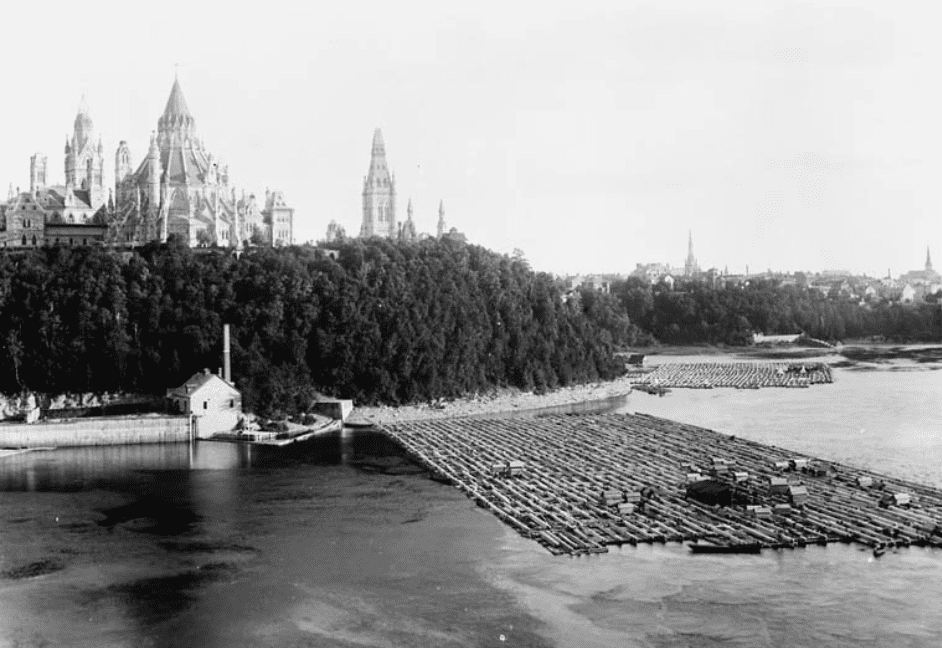 The assembling of a timber raft on the Ottawa River below Parliament Hill. Topley, Library and Archives Canada, PA-00843.
The assembling of a timber raft on the Ottawa River below Parliament Hill. Topley, Library and Archives Canada, PA-00843.
To get the timber to Quebec City, Irish and French lumbermen squared the pine logs. The “sticks,” as they were called, were pulled by teams of horses over greased slides to be launched into the water. There, they were bound together to form cribs using withes, strong, flexible branches of birch and alder. Four cribs made a band. The bands were joined together to assemble a raft. On the raft were cabins to house a crew of thirty or more men. The captain had his own quarters, sufficiently commodious to accommodate the occasional passenger. There was also a cook-house to prepare food and to brew tea.
Travelling down the Ottawa and St. Lawrence Rivers on a log raft was difficult and perilous, especially during the early days before timber slides were built so that rafts could circumvent fast water. The first such slide was built in 1829 by Ruggles Wright, the son of Philemon Wright, on the north side of the Ottawa River to pass logs around the Chaudière Falls, known in English as the Giant Cauldron. Other rapids that had to be bypassed on the way to Quebec City were found at Long Sault near Cornwall, and Lachine, both on the St. Lawrence.
Even with the construction of timber slides to ease their passage, the big rafts had to be broken down into component cribs before entering a slide, and reassembled afterwards. The journey from Ottawa to Quebec City could take a month or more. However, it wasn’t all hard work, at least for the owners. It is reported that lumber barons hosted large parties of MPs and senators to lunches of pork and beans before departing Ottawa. Also, along the way, raft captains entertained lavishly at various stops during the voyage.
Once in Quebec City, the big timber rafts were disassembled in nearby coves, and sold to waiting British merchants for shipment to Liverpool and other British ports.
In 1836, the Ottawa Valley Lumber Association was formed in Bytown, with meetings held in Doran’s Hotel, the town’s chief waterhole of the age. Early lumbermen included James Skead, David Maclaren, J.S. Currier, and the Buchanan brothers, Andrew and Charles. While the square timber trade was generally very profitable, it was also precarious. John Egan, for whom Eganville, Ontario is named, was a power in the timber trade during the mid-nineteenth century, but went bankrupt in 1854 when prices unexpectedly fell.
The era of the square timber raft peaked during the 1840s, and steadily waned thereafter. Mid-century, Britain adopted a free-trade economic policy thereby eliminating a trade preference enjoyed by Canadian timber producers since the Napoleonic Wars. The Royal Navy’s demand for Canadian pine also declined as the age of sail gave way to that of steam.
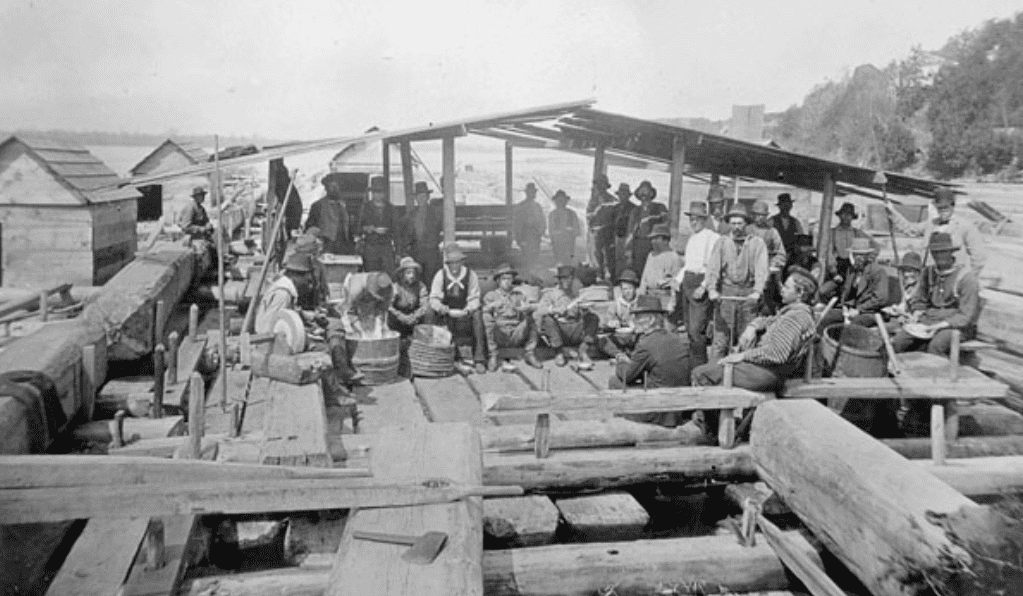 Cook house on a timber raft, Andrew Auborn Merrilees Fonds, Library and Archives Canada, ID No. 3277723.
Cook house on a timber raft, Andrew Auborn Merrilees Fonds, Library and Archives Canada, ID No. 3277723.
But Ottawa’s lumber industry adapted. Demand for Canadian sawn timber rose in the rapidly growing eastern cities of New York and Boston. U.S. entrepreneurs, such as Captain Levi Young, Franklin Bronson, Ezra Eddy, and J.R. Booth, established sawmills on the shores of the Ottawa River, harnessing its fast-flowing water to power their large timber saws. In 1874, 424 million board feet of timber were cut in Ottawa-area sawmills, along with a further 25 million board feet of square timber. The biggest lumber producer at that time was the E.B. Eddy Company whose output amounted to 55 million board feet. Close behind was Gilmour and Company which produced another 50 million board feet. J.R. Booth’s company cut a further 22 million board feet of timber.
By 1902, 613 million board feet of timber were being produced by nineteen sawmills in the Ottawa Valley. J.R. Booth had vaulted into the number one spot, producing an amazing 125 million board feet of timber. His sawmill was reportedly the largest in the world, able to produce more than 1 million board feet of sawn timber in one eleven-hour day.
As the supply of white and red pine in the Ottawa Valley rapidly diminished, Ottawa’s lumber business turned increasingly to pulp and paper production, making use of the spruce and balsam firs which hitherto had been considered of little value. In 1878, E.B. Eddy constructed the first mechanical pulp mill for the manufacture of fibre products. By 1908, E.B. Eddy was producing 160 tons of pulp every day. In 1926, Eddy built a massive sulphite chemical pulp mill in Hull immediately across the Ottawa River from the Parliament buildings.
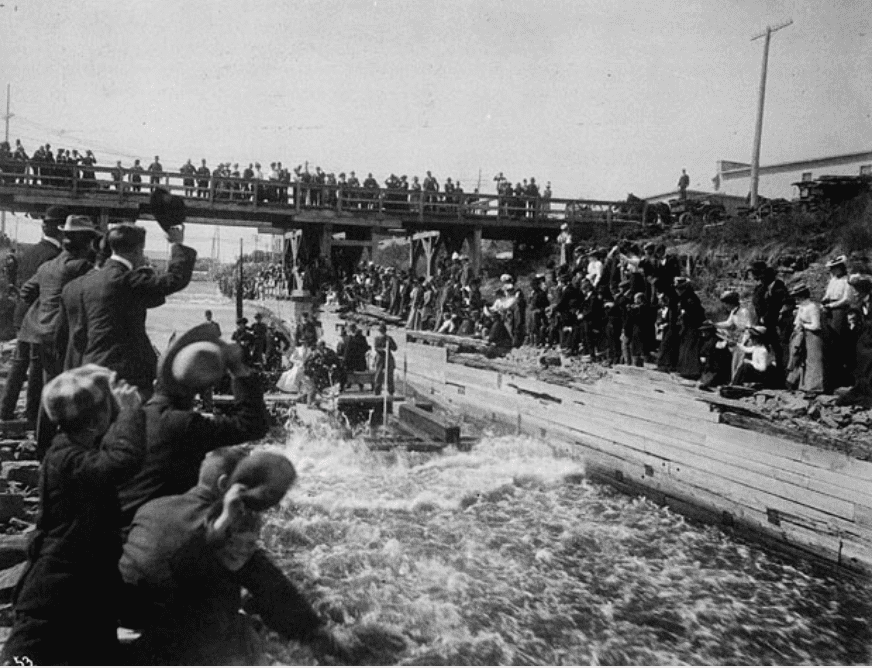 The Duke of Cornwall and York and the Royal Party taking a ride on a crib through the Chaudière log slide, 1901, Charles Berkley fonds, Library and Archives Canada, ID No. 3294381.
The Duke of Cornwall and York and the Royal Party taking a ride on a crib through the Chaudière log slide, 1901, Charles Berkley fonds, Library and Archives Canada, ID No. 3294381.
Owing to waning demand for square timber, and a declining supply of big pine trees, fewer and fewer timber rafts made their way from Ottawa to Quebec City by the end of the nineteenth century. The few that did attracted much attention as the big timber rafts were broken up to make the trip through the government timber slide at the Chaudière Falls before being reassembled below the Parliament buildings for the next leg in their journey to the old capital. Timber rafting became a tourist and spectator sport. An exhilarating trip through the timber slide on a crib became a de rigueur experience for visiting dignitaries. In 1901, the Duke of Cornwall and York, later King George V, took the plunge, just as his father had in 1860.
The last square timber raft to leave for Quebec City from Ottawa began its journey in mid-June 1908 from the upper reaches of the Ottawa River. The Ottawa Citizen reported that the largest raft in years, totalling 135 cribs, owned by J.R. Booth, had descended the Black River in Quebec. The newspaper advised people who wished to see the sight of it shooting the Grand Calumet slide upstream on the Ottawa River to take the CPR train to Campbell’s Bay and the stage to Bryson, Quebec.
On or about 8 July 1908, this last timber raft was ready for its transit through the government slide at the Chaudière Falls. We know this date from newspaper accounts of an inquiry into a hit and run accident that occurred in Ottawa. The suspect, a hackman, F.J.X. Lascelles, had been hired on 8 July to work on Booth’s timber raft going to Quebec City. Another newspaper account two days later advised people to go watch the running of the cribs through the Chaudière timber slide then underway as it was “probably the last [timber raft] that will ever pass down the Ottawa to Quebec City.” Hundreds of spectators took the newspaper’s advice to watch the event. After passing through the slide, the cribs were reassembled below the Parliament buildings into the log raft for its voyage to Quebec City under the direction of pilot Ephrem Lalonde, a raftsman of more than forty years’ experience.
The Ottawa Citizen remarked that this was the end of the adventurous method of transporting timber which had been the most picturesque feature of the timber industry. Subsequent loads of timber were transported by rail.
After peaking during the beginning the twentieth century, the Ottawa Valley timber industry entered a long decline as its supply of wood dwindled. By the mid-1920s, it was estimated that less than four percent of the Ottawa Valley’s original, old-growth forest remained, consisting of not more than 10 billion feet of pine of saw-sized timber, with a further 5 billion feet of other soft woods and 4 billion feet of hard woods. Secondary growth of soft and hard woods was deemed suitable only for pulp and firewood.
Lumbermen looked back in dismay at the wasteful practices of the past. Squaring logs led to the wastage of more than one-third of the wood. Giant hemlocks were cut down solely for their bark used for tanning leather, the wood left to rot where the trees were felled. Land clearances for farms destroyed countless acres of valuable timber. The dead branches and brush from cut trees also provided the fuel for massive forest fires that destroyed valuable stands of timber.
Today, the lumber and paper mills of Ottawa-Hull are mostly gone. The J.R. Booth Company was bought out by E.B. Eddy in 1943, the first of many mergers and closures. Domtar acquired the E.B. Eddy mills in Ottawa and Gatineau in 1998, and permanently closed them in 2005 and 2007, respectively. The site of the big Eddy pulp mill on the north shore of the Ottawa River across from Parliament Hill is now the location of the Canadian Museum of History. All that is left is the former Eddy paper mill on Laurier Street in the Hull sector of Gatineau. The mill has been owned by Kruger, a Quebec-based forest product company, since 1997.
Although the lumber industry was the backbone of the Ottawa economy for close to two hundred years, providing jobs for thousands, the prosperity that it generated came at a high environmental cost. The industry irrevocably altered the landscape of the Ottawa Valley with the destruction of virtually all of its original woodland. Along with it went the traditional way of life of the Indigenous people of the Ottawa Valley, who never ceded ownership of its territory to European setters. The industry also had serious negative consequences for the Ottawa River. Dams built to control water levels to facilitate the transport of logs and to power the sawmills disturbed fish habitats. Sunken logs, and saw dust, routinely dumped into the river, along with chemicals from the pulp and paper mills, and untreated city effluents, polluted the water, killed fish, and brought disease.
Fortunately, with the closure of most of the mills and more effective treatment of city sewage and runoff, water quality in the Ottawa River is improving. However, the extent of the improvement is not known. According to the Ottawa Riverkeeper, water quality monitoring is piecemeal throughout the Ottawa River watershed, and there is no program in place to monitor the quality of water in the Ottawa River over time.
A lasting legacy of Ottawa’s lumbering past is the ring dam at the Chaudière Falls. Once used to make electricity to drive the sawmills, it now produces clean energy to help power downtown Ottawa. While the once dirty industrial area has been greened and opened to the public, the dam’s continued presence remains controversial.
Forestry continues in the Ottawa Valley, though on a much-reduced scale from its glory days. Its focus today is on sustainable forestry practices that respect not only the economic value of the forest but also its cultural and ecological significance.
Sources:
Canadian Museum of History, 2020. The Timber Trade, https://www.historymuseum.ca/cmc/exhibitions/hist/canp1/ca14eng.html.
Hirsch, R. Forbes, 1985. The Upper Canada Timber Trade: a sketch, Bytown Pamphlet No. 14, Historical Society of Ottawa.
Ottawa Citizen, 1908. “Big Raft Coming,” 15 June.
——————, 1908. “Comment,” 10 July.
——————, 1908. “Police Doing Clever Work,” 17 July.
——————, 1926. “For Over One Hundred Years District Has Been Greatest Lumber Producer In Canada,” 16 August.
——————, 1936. “Had Exciting Adventure On A Journey To Quebec On A Raft,” 15 February.
——————, 2006. “Kruger to change Scott names as Kimberly-Clark deal ends,” 11 October.
Ottawa Journal, 1976. “Great timber trade began on Hull side,” 27 September.
Ottawa Riverkeeper, 2020. Water Quality and Quantity, https://www.ottawariverkeeper.ca/ottawa-river-water-quality/.
OttawaRiver.org, 2005. A Background Study for Nomination of the Ottawa River Under the Canadian Heritage Rivers System – 2005, https://ottawariver.org/pdf/01-intro.pdf.
Outaouais’ Forest History, 2020. http://www.histoireforestiereoutaouais.ca/en/.
Whitton, Charlotte, 1967. “The Ottawa: My land of the white pine tree,” Ottawa Citizen, 27 June.
Story written by James Powell, the author of the blog Today in Ottawa's History.
Retired from the Bank of Canada, James is the author or co-author of three books dealing with some aspect of Canadian history. These comprise: A History of the Canadian Dollar, 2005, Bank of Canada, The Bank of Canada of James Elliott Coyne: Challenges, Confrontation and Change,” 2009, Queen’s University Press, and with Jill Moxley, Faking It! A History of Counterfeiting in Canada, 2013, General Store Publishing House, Renfrew, Ontario. James is a Director of The Historical Society of Ottawa.
Ottawa's Royal Swans
28 June 1967
In Britain, there has been an association between the monarchy and mute swans (Cygnus Olor) that dates back to the twelfth century. Traditionally, the Crown claims ownership of all mute swans in open water in England and Wales. The monarch can, however, give the privilege of owning swans to others. In 1483, King Edward IV ruled that only the gentry owing land worth more than five marks (£3. 7s. 6d.) could own “swannes.” Today, other than the Crown, only three groups hold the privilege of owning the waterfowl—the Company of Vintners and the Company of Dyers, who received the right in the 1460s, and the Ilchester family of Abbotsbury, Dorset. The Ilchester family gained the privilege when it acquired property previously owned by Benedictine monks following the dissolution of the monasteries during the sixteenth century by King Henry VIII. Today, the Queen’s swan rights are only enforced over part of the Thames River. Each year, at the ceremonial “Swan Upping,” held during the third week in July, young swans, called cygnets, are rounded up on the river between the towns of Sunbury and Abingdon and distributed among the Crown and the two Companies. In the old days, the beaks of the swans going to the Companies were marked, one nick for Dyers’ birds and two nicks for Vintners’ birds. Birds owned by the Crown were left unmarked. Today, instead of nicking the beaks, the birds are banded.
You might wonder why all the bother. The purpose of the modern “Upping” is not so much about ownership but rather about monitoring the health of the mute swan population on the Thames. It’s also about having fun, dressing up in fancy uniforms and getting out on the water in traditional wooden skiffs on a warm, summer’s day. Back in medieval times, however, it was very serious business. Swans were a valuable commodity, and were eaten as poultry, much like chickens, ducks and geese are today. Swan was the fowl of choice of the aristocracy at feasts. But for some reason, swan flesh went out of fashion. The taste might have been a factor. While Master Chef Mario Batali claims swan meat is “delicious—deep red, lean, lightly gamey, moist, and succulent”—others have called it “gristly” and “mud flavoured.” If you happen to come across swan at your neighbourhood butcher (most unlikely), and wish to give it a try, here is a link to a fourteenth-century recipe for roasted swan with chaudon (a.k.a. giblet) sauce. Roasted swan.
Royal mute swans came to Ottawa in 1967, Canada’s centennial year, as a gift to the nation’s capital from Queen Elizabeth who also doubles as Seigneur of Swans. It was not the first time that Canada has received Royal swans. In 1912, George V gave a pair of Royal mute swans from his flock at Hampton Court to St Thomas, Ontario. The birds were settled on Pinafore Lake. They didn’t flourish. More mute swans were imported in the early 1950s from the United States, Scotland and from Stratford, Ontario which itself received mute swans in 1918 from Mr J. C. Garden. Today, St Thomas’s imported mute swans have been replaced by native trumpeter swans (Cygnus buccinator) in a programme to re-introduce the breed into southern Ontario. King Edward VIII also presented two Royal swans to North Sydney, Nova Scotia in 1936.
The gift of swans has not always been unidirectional. In 1951, the Federal and British Columbian governments gave six Canadian trumpeter swans to the then Princess Elizabeth. The swans were put into the care of the Severn Wild Fowl Trust.
Ottawa’s Royal mute swans arrived in the city in late May 1967, the culmination of careful planning on the part of Buckingham Place, Rideau Hall, the City of Ottawa, the Federal government and two airlines. Arriving by airplane at Uplands Airport, the birds, which had been specially selected by the Keeper of the Queen’s Swans from the Thames River, were placed into precautionary quarantine. At 4pm on 28 June 1967, following speeches by the Governor General and Ottawa’s Mayor Donald Reid in front of hundreds of guests, eight Royal swans were released into the Rideau River just above the Rideau Falls on the grounds of the old city hall (now the Federal government’s John G. Diefenbaker building) on Green Island. Two other pairs of swans remained at the “swan house” at the City’s Leitrum tree nursery for breeding purposes. Noting that swans mated for life, Governor General Roland Mitchener joked that in light of the prospective liberalization of Canada’s divorce laws, the birds might have to face “some previously unknown temptations.” The birds’ ability to fly was disabled to stop them from straying, physically if not maritially.
The swans were in place on July 1, 1967, Canada’s centennial day, ready for the Queen’s inspection when she and Prince Philip arrived at City Hall on their Royal Tour of Canada. The Ottawa Journal wrote that the swans, paddling from shore to shore on the Rideau River “enhanced a scene of calm and beauty.” Their “regal beauty complemented every natural and man-made fixture in sight.”
The graceful, long-necked, white birds were an instant sensation as they cruised the Rideau River, stopping along the way to eat aquatic vegetation, as well as the odd tadpole, snail or insect. Couples quickly established territories along the river bank. When the cold weather came in late October, the birds were moved to their winter quarters at Ottawa’s tree nursery in Leitrim. There, they were housed in less than regal surroundings in a greenhouse made of heavy-duty plastic and chicken wire with an earthen floor and an artificial pond. In 1971, a wooden swan house was built with pens for each couple and an outside exercise yard. The birds were cared by Ottawa’s first swanmaster, Mr. Gerry Strik, who was also the manager of the Leitrim tree nursery. Mr. Strik had previous experience caring for swans in his native Holland. That same year, the Royal swans made their theatrical debut, appearing in the National Arts Centre production of The Marriage of Figaro. Swanmaster Strik, dressed appropriately, was in the wings in case the birds misbehaved. Appearing on stage for the entire final act, the swans performed admirably.
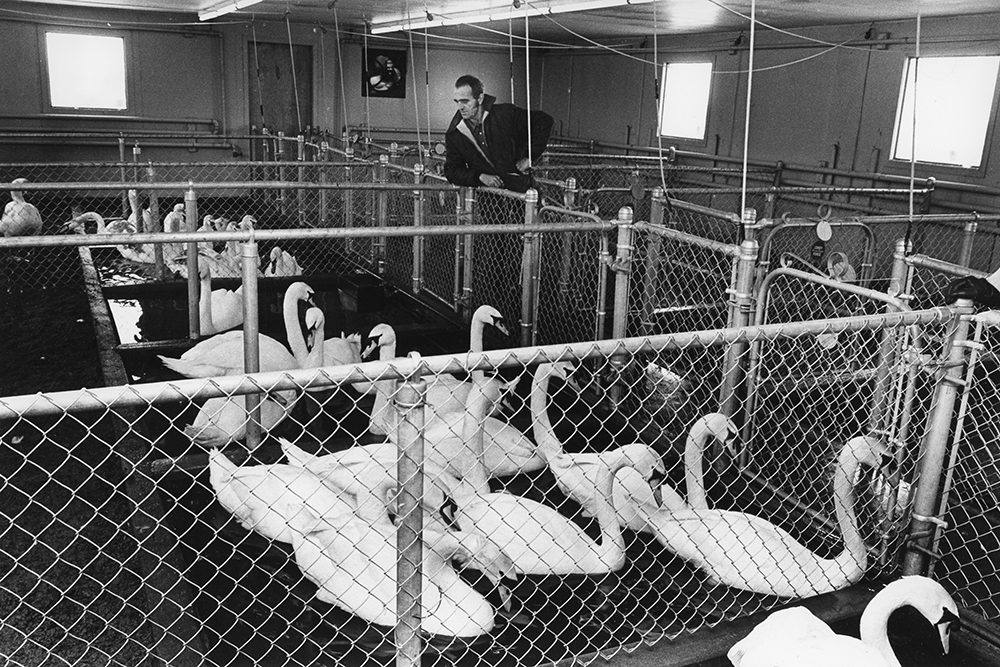 Swanmaster-Gerry Strik with Royal swans at their indoor winter quarters, March 9, 1978, City of Ottawa Archives/CA025513/Peter Earle.
Swanmaster-Gerry Strik with Royal swans at their indoor winter quarters, March 9, 1978, City of Ottawa Archives/CA025513/Peter Earle.
There were, however, some reservations about the new Rideau River inhabitants. One City Councillor worried that the honking of swans might be a violation of the city’s anti-noise by-law. His concern was allayed by Margaret Farr, the deputy commissioner of Ottawa’s Parks and Recreation Department. She said the birds were relatively quiet, though they sometimes “grunted like pigs.” Another councillor worried about the swans’ reproductive capacity. As mute swans lay clutches of up to five eggs, he figured that within five years Ottawa could be the proud owner of 72 pairs of birds. Mute swans are also long-lived, with a lifespan of thirty years or more.
This later concern turned out to be prophetic. Quickly, the swan population rose despite losses due to disease and misfortune. Sadly, there were also a number of cases of cruelty towards the birds and their nestlings. Eggs were also destroyed. One adult bird was shot while another was clubbed to death with a baseball bat. Yet another was found dead with a fish hook in its mouth. Two disappeared without a trace, presumably taken by somebody with a taste for swan flesh. Despite such losses, by the early 1970s, there were forty birds, and the City was looking around for solutions to limit their numbers; forty birds was deemed to be the maximum the Rideau River could accommodate. This gave rise to an interesting problem. Would it be a case of lèse majesté to dispose of some swans? After consulting the British High Commissioner and the Governor General, both of whom didn’t have an answer, the question was resolved by the Lord Chamberlain of England. His answer was there was no problem if the City gave swans away to good homes. However, such birds could not be designated as royal gifts. The Queen herself suggested that only two eggs be left in each nest.
Despite concerns about swan numbers, Ottawa acquired a pair of black Australian swans (Cygnus atratus) in July 1974. The source of the birds and the rationale for acquiring them are a bit murky. According to the City of Ottawa’s website, the birds came from the Montreal Zoo in an exchange. However, contemporary newspaper reports say they came to Ottawa in a trade with Wallaceburg, Ontario. These birds do not carry the “Royal” designation as they were not a gift from the Crown.
By the early 1990s, City Council, looking for cutbacks in an age of austerity, considered eliminating the city’s swans, and in the process saving some $37,500 or more per year in winter maintenance, a cost that had increased ten-fold since 1967 due partly to inflation and partly to the increase in the swan population. One city official jokingly suggested that Ottawa host a big barbecue. After receiving hundreds of letters in support of the birds, City Council instead agreed to reduce their numbers to save money. A few years later, City Council again tried to eliminate the swans. Jim Watson, a city alderman at the time, called the swans “a frill.” Fortunately for swan lovers, the high-tech. company Cognos stepped up in early 1996, providing $26,300 to cover that year the maintenance costs of twenty-two white Royal swans and 5 black Australian swans. The company continued to pay for the swans’ maintenance until 2007. The following year, IBM, which had taken over Cognos, stepped in and contributed $300,000 in a lump sum for the maintenance of the birds.
About the same time, concerns were raised about deteriorating conditions at the swan house at the Leitrim Tree Sanctuary. Although called “Swantanamo Bay” by some wags after the notorious U.S. military and prison camp in Cuba, the Ottawa Humane Society said the unsightly facility did not pose a “significant health or safety risk” to the birds. With IBM funds devoted to the annual maintenance of the birds, the city looked into building replacement quarters for the birds. With the estimated cost approaching $500,000 (!), the idea of building a new swan house was quickly shelved. When the Leitrim facility finally closed in 2015, the birds were sent to winter quarters at Parc Safari in Hemingford, Quebec under a two-year arrangement costing roughly $30,000 per year.
Typically, the swans are released back into the Rideau River in late May. However, in 2017, the swans, now a much reduced group of eight, six Royal mute swans and two black Australian swans, were released in late June owing to high water conditions prevailing earlier in the spring. Mayor Jim Watson and Councillor Diane Deans officiated at the event held at Brantwood Park at the end of Clegg Street.
How many more years this annual event will take place remains an open question. While the Royal mute swans are attractive and have many admirers, they are considered an invasive species in North America that competes with native trumpeter swans. Although Ottawa’s swans on the Rideau are pinioned, a requirement of the Federal Wildlife Act in order to stop them flying away and going feral, pinioning is a controversial procedure. Liken to the cropping of the tail and ears of certain breeds of dogs or removing the claws of cats, pinioning involves the surgical removal of the pinion joint of the wing. This procedure permanently stops a bird’s flight feathers from growing thereby disabling its ability to fly. It’s typically done without anesthesia, and is banned in some countries under animal protection laws. While Ottawa’s Royal swans made it through 2017, Canada’s sesquicentennial year (and the 50th anniversary of the Queen’s gift), their future is not bright unless another sponsor steps forward.
Update: In a 20-2 decision, Ottawa City Council agreed in June 2019 to give the remaining four royal mute swans and one Australian black swan to Parc Safari in Hemingford. Apparently, their numbers had been affected by predation by coyotes. The aging birds were also being stressed by moving back and forward from Hemingford to Ottawa.
Sources:
Answer Fella, 2011. “Why Not Eat a (Black) Swan on Oscar Night?” Esquire, 23 February, http://www.esquire.com/food-drink/food/a9453/black-swan-recipe-0311/.
Barger, Brittani, 2016, “Does the Queen really own all the swans?” Royal Central, http://royalcentral.co.uk/blogs/does-the-queen-really-own-all-the-swans-57621.
CBC, News, 2008. “IBM bails out Ottawa’s royal swans,” 20 November.
Cornell, Lab of Ornithology (The), 2017. “Mute Swan,” https://www.allaboutbirds.org/guide/Mute_Swan/lifehistory.
Duhaime.org. 2007. Crazy Laws—English Style (1482-1541), http://www.duhaime.org/LawFun/LawArticle-359/Crazy-Laws–English-Style-1482-1541.aspx.
Field, Mrs Marshall (Dolly), 1951. History of the St. Thomas Filed Naturalist Club, 1950-67), http://inmagic.elgin-county.on.ca/ElginImages/archives/ImagesArchive/pdfs/ECVF_B99_F30.pdf.
Globe and Mail, The, 1951. “To Send Royal Pair Gift Of 6 Swans,” 10 November.
————————–, 1955. “The Swans of St. Thomas,” 10 December.
————————–, 1992. “Squaking Squelches Notion Of Swan Song,” 23 April.
————————-, 1996. “With Her Swans Looked After,” 10 January.
————————-, 1996. “Cognos Picking Up Tab For Swans, $26,300 per year.” 10 October.
Gode Cookery Presents, 2017. “For to dihyte a swan,” Medieval recipes, http://www.godecookery.com/mtrans/mtrans52.html.
Ottawa, City of, 2016. “Royal swans to be released along the Rideau River,” 20 May.
——————, 2016. “Royal swans make annual return to the Rideau River,” 24 May.
——————, 2017. “Royal Swan FAQs,” http://ottawa.ca/en/residents/animals-and-pets/other-animals#royal-swan-faqs.
Ottawa Humane Society, 2013. Royal Swan FAQs, https://web.archive.org/web/20091203010345 /http://www.ottawahumane.ca/protection/swan.cfm
Ottawa, Journal (The), 1967.”Swans Fly Atlantic – By Plane,” 31 May.
—————————, 1967. “Royal Swan Song Worries Council,” 20 June.
—————————, 1967. “Mitchener To Present,” 21 June.
—————————, 1967. “Letter to Citizens of Ottawa from Mayor Don Reid,” 27 June.
—————————, 1967. “City’s Royal Swans ‘Launched,’” 29 June.
—————————, 1967. “Those Royal Swans,” 8 July.
—————————, 1967. “The Royal Swans,” 15 July.
—————————, 1967. “Swans To Winter In Leitrim,” 21 October.
—————————, 1971. “Royal Swan Upkeep Set At $3,500 in 1971.” 20 May.
—————————, 1971. “Royal Swans Have Part In NAC Opera,” 6 July.
—————————, 1971. “Royal Swan Clubbed to Death,” 21 October.
—————————, 1972. “Yes—Swans Can Be Given Away,” 20 March.
—————————, 1973. “Royal Swans….” 24 March.
—————————, 1973. “Queen Finds Answer To City’s Swan Dilemma,” 2 August.
—————————, 1978. “It’s Your Royal Flock,” 19 May.
—————————, 1979. “Swan Song,” 13 September.
—————————, 1979. “Attempt To Cut Numbers by 8 To 20 Defeated.” 13 October.
Ottawa Sun, 2016. “City Still Trying To Find A Permanent Winter Facility,” 24 November.
Queen’s Swan Marker, 2012. Royal Swan Upping, The Queen’s Diamond Jubilee Edition, http://www.royalswan.co.uk/sources/indexPop.htm.
Shaw, Hank, 2015. On Eating Swans, http://honest-food.net/on-eating-swans/.
Stratford, City of, 2007. “The Swans of Stratford,” http://www.visitstratford.ca/uploads/brochure2007c.pdf.
St. Thomas Times Journal, 2013. “Nature takes toll on St. Thomas swan cygnets,” 21 August.
Toronto, City of, 2011, “Birds of Toronto,” https://www1.toronto.ca/City%20Of%20Toronto/City%20Planning/Environment/Files/pdf/B/Biodiversity_Birds_of_TO_dec9.pdf.
Story written by James Powell, the author of the blog Today in Ottawa's History.
Retired from the Bank of Canada, James is the author or co-author of three books dealing with some aspect of Canadian history. These comprise: A History of the Canadian Dollar, 2005, Bank of Canada, The Bank of Canada of James Elliott Coyne: Challenges, Confrontation and Change,” 2009, Queen’s University Press, and with Jill Moxley, Faking It! A History of Counterfeiting in Canada, 2013, General Store Publishing House, Renfrew, Ontario. James is a Director of The Historical Society of Ottawa.



